Sandmartin DCM4-HDR Digital Video Broadcasting User Manual DCM4 HDR English V1 0
Sandmartin(Zhong Shan) Electronic Co., Ltd. Digital Video Broadcasting DCM4 HDR English V1 0
DCM4-HDR_English_V1

Important Safety Instructions
1
SAFETY PRECAUTION
Important Safety Instructions
1, Read these instructions
2, Keep these instructions
3, Heed all warnings
4, Follow all instructions
5, Do not use this apparatus near water
6, Clean only with dry cloth
7, Do not block any ventilation openings. Install in accordance with the
manufacturer’s instructions.
8, Do not install near any heat sources such as radiators, heat registers, stoves,
or other apparatus (including amplifiers) that produce heat.
9, Do not defeat the safety purpose of the polarized or grounding-type plug. A
polarized plug has two blades with one wider than the other. A grounding type
plug has two blades and a third grounding prong. The wide blade or the third
prong are provided for your safety. If the provided plug does not fit into your
outlet, consult an electrician for replacement of the obsolete outlet.
10, Protect the power cord from being walked on or pinched particularly at plugs,
convenience receptacles, and the point where they exit from the apparatus.
11, Only use attachments/accessories specified by the manufacturer.
12, Use only with the cart, stand, tripod, bracket, or table specified by the
manufacturer, or sold with the apparatus. When a cart is used, use cautions
when moving the cart/apparatus combination to avoid injury from tip-over.
13, unplug this apparatus during lighting storms or when unused for long
periods of time.
14, Refer all servcing to qualified service personnel. Servicing is required when
the apparatus has been damaged in any way, such as power-supply cord or
plug is damaged. Liquid has been spilled or objects have falled into the
apparatus, the apparatus has been exposed to rain or moisture, does not
operate normally, or has been dropped.
15, WARNING: to reduce the risk of fire or electric shock, do not expose this
apparatus to rain or moisture.
16, The mains plug is used as the disconnect device, the disconnect device
shall remain readily operable.
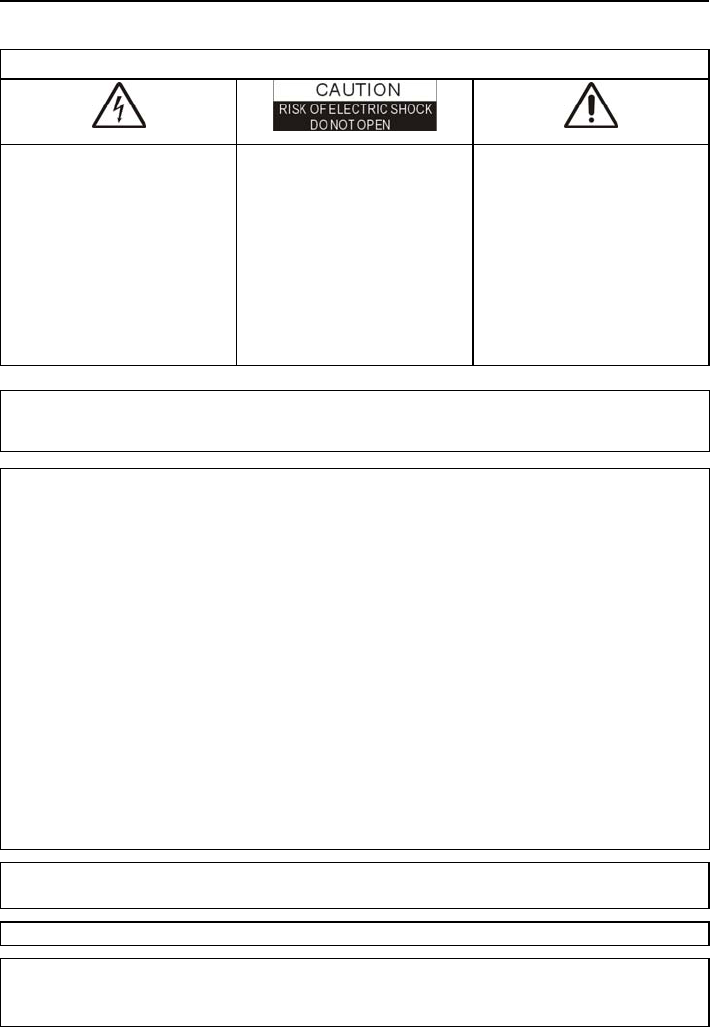
Important Safety Instructions
2
SAFETY PRECAUTION
CAUTION:
The lightning flash with
arrowhead symbol, within an
equilateral triangle, is
intended to alert the user to
the presence of "dangerous
voltage" withink the product
enclosure that may be so
sufficient magnitude to
constitute a risk of electric
shock to a person.
Warning:
To reduce the risk of electric
shock, do not open the cover
or cabinet. No user
serviceable parts inside.
Refer servicing to qualified
personnel only.
The exclamation point within
an equilateral triangle is
intended to alert the user to
important operating and
maintenance (servicing)
instructions in the literature
accompanying the
apparatus.
Caution: The user is cautioned that changes or modifications not expressly
approved by the party responsible for compliance could void the user's authority
to operate the equipment.
For a Class B digital device or peripheral, the instructions furnished the user
shall include the following or similar statement, placed in a prominent location in
the text of the manual:
Note: This equipment has been tested and found to comply with the limits for a
Class B digital device, pursuant to part 15 of the FCC Rules. These limits are
designed to provide reasonable protection against harmful interference in a
residential installation. This equipment generates, uses and can radiate radio
frequency energy and, if not installed and used in accordance with the
instructions, may cause harmful interference to radio communications.
However, there is no guarantee that interference will not occur in a particular
installation. If this equipment does cause harmful interference to radio or
television reception, which can be determined by turning
the equipment off and on, the user is encouraged to try to correct the
interference by one or more of the following measures:
—Reorient or relocate the receiving antenna.
—Increase the separation between the equipment and receiver.
—Connect the equipment into an outlet on a circuit different from that to which
the receiver is connected.
—Consult the dealer or an experienced radio/TV technician for help
WARNING: The apparatus shall not be exposed to dripping or splashing of liquids.
No objects filled with liquids, such as vases, shall be placed on the apparatus.
WARNING: Do not put a candle or lamp on the cabinet, as this can cause a risk of fire.
WARNING: The unit should be connected to a power supply only of the type described in
the operating instructions or as marked on the unit. If you are not sure of the type of
power supply to your home, consult your local dealer or power company.
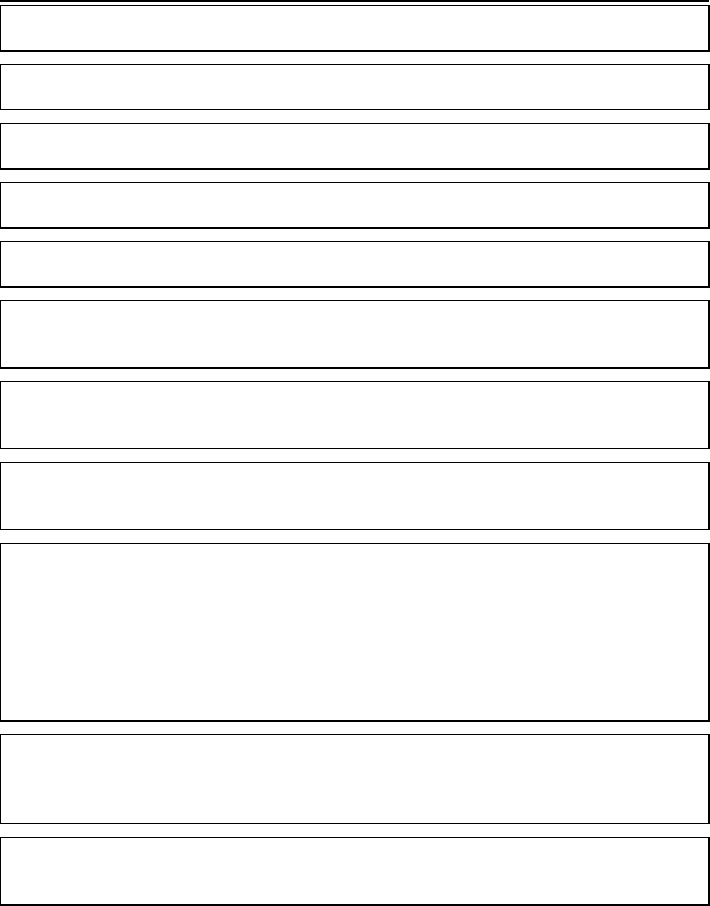
Important Safety Instructions
3
WARNING: The batteries of the remote control should not be exposed to excessive heat
such as fire, direct sun, or similar.
WARNING: Maintenance personnel must use the appropriate tools and replacement
parts as specified by the manufacturer.
Note: Do not open the cabinet on this unit, as this may expose you to dangerous
voltages and radiation.
Unit Cleaning: After the unit power is turned off, you can clean the cabinet, panel and
remote control with a soft cloth lightly moistened with a mild detergent solution.
Attachments: Never add any attachments and/or equipment without the manufacturer’s
approval, as this may result in the risk of fire, electric shock or other personal injury.
Locating: Slots and openings in the cabinet are provided for ventilation to protect it from
overheating. Do not block these openings or allow them to be blocked by placing the unit
on a bed, sofa or other similar surface.
Power-Cord Protection: Place the power-supply cord out of the way, where it will not be
walked on or pinched, particularly at plugs, convenience receptacles, and the point
where they exit from the unit.
Object and Liquid Entry: Never put objects of any kind into this unit through openings,
as they may touch dangerous voltage points or short-out parts that could result in a fire or
electric shock. Never spill any liquid on the unit.
Note: Moisture may be formed inside the unit under the following conditions:
When the unit is suddenly moved from a cold environment, or an air-condition
room, to a warm place.
Immediately after a heater has been turned on.
In a steamy or very humid room.
If moisture forms inside the unit, it may not operate properly. To correct this problem, wait
several hours for the moisture to evaporate before operating the unit.
Parts Replacement: When the unit parts need to be replaced, user should make sure
the service technician uses the replacement parts specified by the manufacturer or
having the same characteristics as the original part. Unauthorized replacement may
create a risk of fire, electric shock or other hazards.
Safety Check: After all the maintenance and repairs are done, the user should request
the service technician conduct an overall safety check, to ensure the unit is in proper
operating condition.
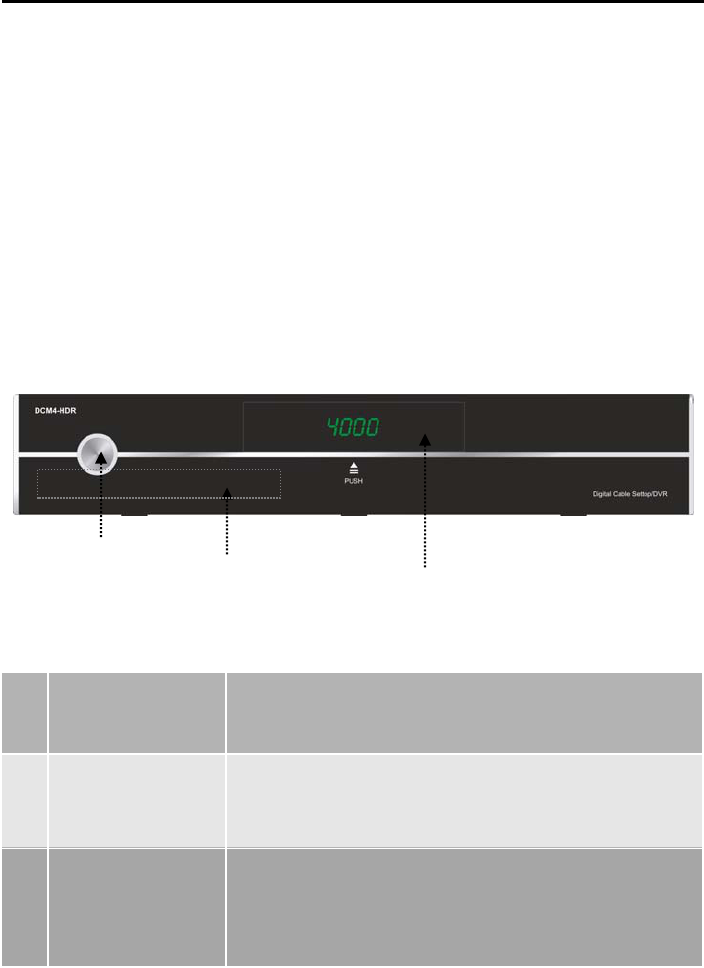
4
Remote Control & Panel Description
Power/
Standby
Menu, CH+/-,
Vol +/-, OK Remote
Sensor
1. Settop Description & Remote Control
1.1 Settop Description
This Settop allows you to receive unencrypted (free) and encrypted (paid tier)
Digital Cable programs from your Cable TV Service Provider.
The Settop will search for additional new channels as soon as you launch the
automatic channel search. All Settop settings can be easily configured via the
user interface (Settop Menu).
1.2 Front Panel Description
1 POWER Button Used to switch the Settop between the ON mode
and Standby mode (Make sure the rear panel
ON/OFF switch is set to ON
)
.
2 Remote Sensor Detects the infrared (IR) signals from the remote
control unit. Point your remote toward this area
when selecting channels, adjusting volume, etc.
3 Display (VFD) When the Settop is on, this will display the Channel
Number you are watching.
When the Settop is in standby mode, this will
display the current Time.
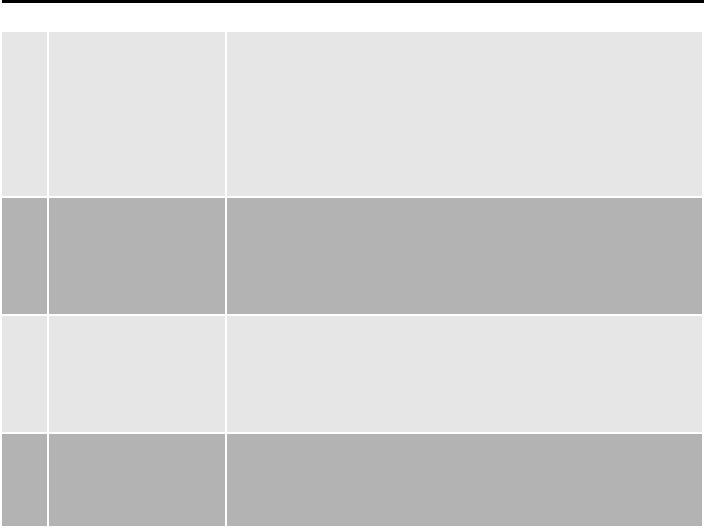
5
Remote Control & Panel Description
4 VOL+/- Press these buttons to adjust the sound level. You
may also need to adjust your TV volume control to
achieve the desired sound level.
These will also serve as Cursor buttons, for
navigating and changing preferences in the Settop
Menu.
5 MENU This button allows you to enter the Settop Menu,
making it possible to set the Settop features to your
preference without using the remote control.
This button will also allow you to exit all Menus.
6 CH+/- Press these buttons to change the channel.
These will also serve as Cursor buttons, for
navigating and changing preferences in the Settop
Menu.
7 OK Press this button to display the channel list.
This button will also serve as the OK button while in
the Settop Menu.
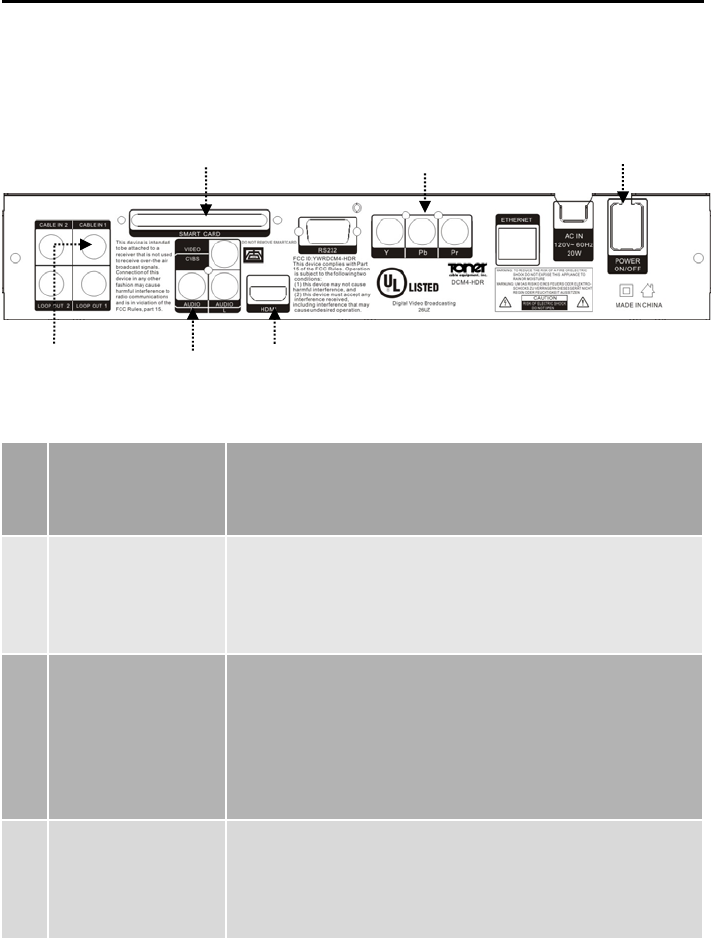
6
Remote Control & Panel Description
Cable
Input
Smart Card
Component
Output
HDMI
Output
Video, L/R
A
udio Output
Power
Switch
1.3 Rear Panel Description
1 CABLE IN CABLE input of the tuner. Connect your Cable TV
signal to this jack.
2 LOOP OUT CABLE output for connecting Cable TV signal to
another device. This jack will output the cable
signal at all times, whether the receiver is on or off.
3 SMART CARD
De-scramble pay TV services for
encrypted-premium channel content reception
(contact your Cable TV Provider for this Card and
to order programming). Be sure the Smart Card is
inserted with proper orientation.
4 VIDEO Composite video output for connecting to your TV
video Input jack. This connection will support
NTSC/480i video.
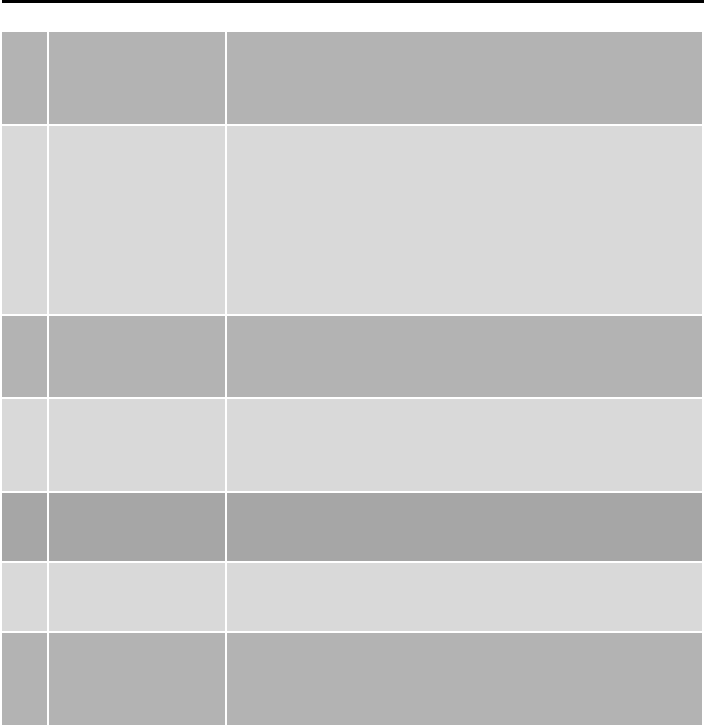
7
Remote Control & Panel Description
5 AUDIO
AUDIO output for connecting to your TV Audio
Input jacks.
6 HDMI High Definition Multimedia Interface connection.
This connection enables secure distribution of
uncompressed high-definition video and audio, in a
single cable. Because signals remain in digital
format, HDMI assures that the images retain the
highest video quality from your Settop to your TV.
7 RS 232 Serial Port allowing software upgrades.
8 Y Pb Pr Component output for connecting high quality
Video to your TV.
9 ETHERNET Connect to the network.
10 AC IN Main Power cord for your Settop.
11 POWER
ON/OFF
Allows user to completely switch off power to the
Settop, without having to unplug the Main Power
cord.
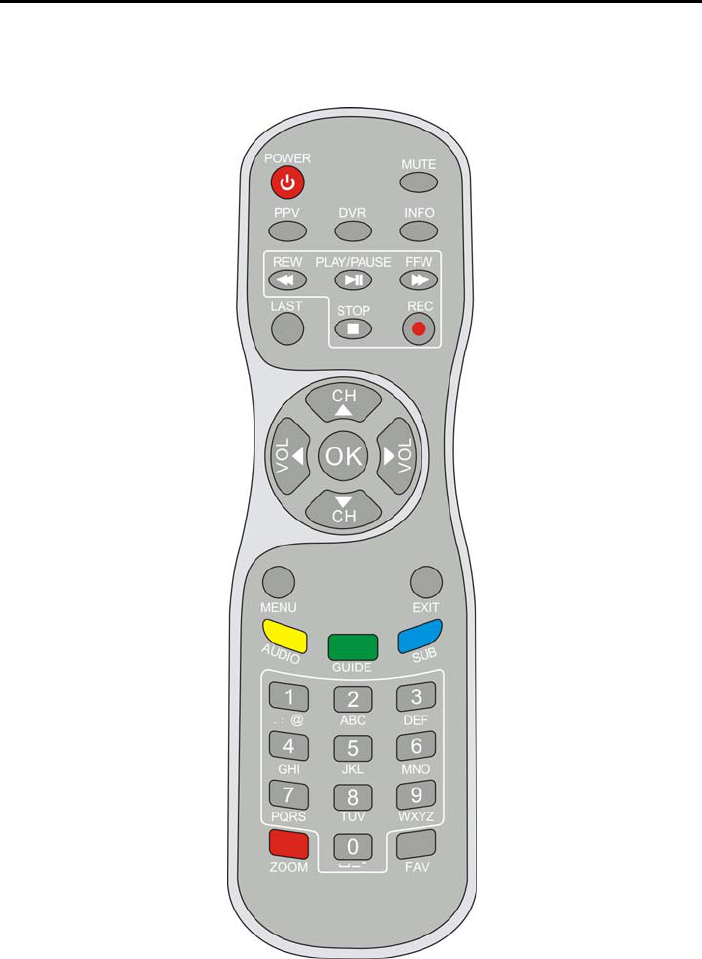
8
Remote Control & Panel Description
1.4 Remote Control Description

9
Basic Operation
2. Basic Operation
2.1 Switch ‘ON’ the Settop
First, plug in your Settop. Next, set the Power ON/OFF switch on the rear
panel of the Settop to ‘ON’. Then, press the [Power] button on the front panel
or remote control, to turn the Settop ON. When the Settop is first used, it will
start a ‘First Time Setup’ walk-thru operation.
? Frequently Asked Question
Q: My Settop is powered on, but the TV screen shows nothing:
A: Make sure your TV is set to the correct video input. For example, if you
have connected the Settop to the HDMI1 input of your TV, then you need to
select the corresponding input of the TV.
Q: My Settop is powered on, but only a “No Signal” display is shown.
A: The channel you selected has no signal. This can be caused by
several reasons:
1. The channel you selected currently has no programming from your cable
provider. Select another channel.
2. The signal of the current TV channel is too weak. You can try changing to
another channel with a stronger signal. If the problem still exists, please
consult your local Cable TV Provider.
2.2 Standby Mode
1. Press the [Power] button on the front panel or remote control, to switch from
operational mode [ON] to standby mode [OFF].
2. In standby mode, press the [Power] button on the front panel or remote
control, to switch to operational mode [ON]. The last active channel will be
tuned and displayed.
3. To switch the Settop off completely, set the Power ON/OFF button on the
Rear Panel to [OFF]. Or, you may unplug the main power cord from the AC
wall outlet.

10
Basic Operation
2.3 MUTE
1. Press the [Mute] button to mute the sound. An icon will be displayed on the
screen to indicate the sound has been muted.
2. Press the [Mute] button again to restore the sound.
2.4 AUDIO
1. Press the [Audio] button to open the
Audio Mode window.
2. Select the desired audio program with
[CH▲/▼] and change the value with
[VOL◄/►].
2.5 LAST
Press the [LAST] button to toggle between
the current channel and the previously selected channel.
*You may also use this [PGDN / RECALL] button when in the GUIDE to quickly
page down thru the available channels.
2.6 Channel Numbers
Enter the channel number directly with your remote control and confirm the
number with the [OK] button, to change to the desired channel.
2.7 PPV
<This section left blank intentionally>
2.8 GUIDE
The Settop has an Electronic Program Guide (EPG) to help you navigate
through all available channels. The EPG supplies information such as channel
listings, program descriptions, and starting/ending times for all programs.
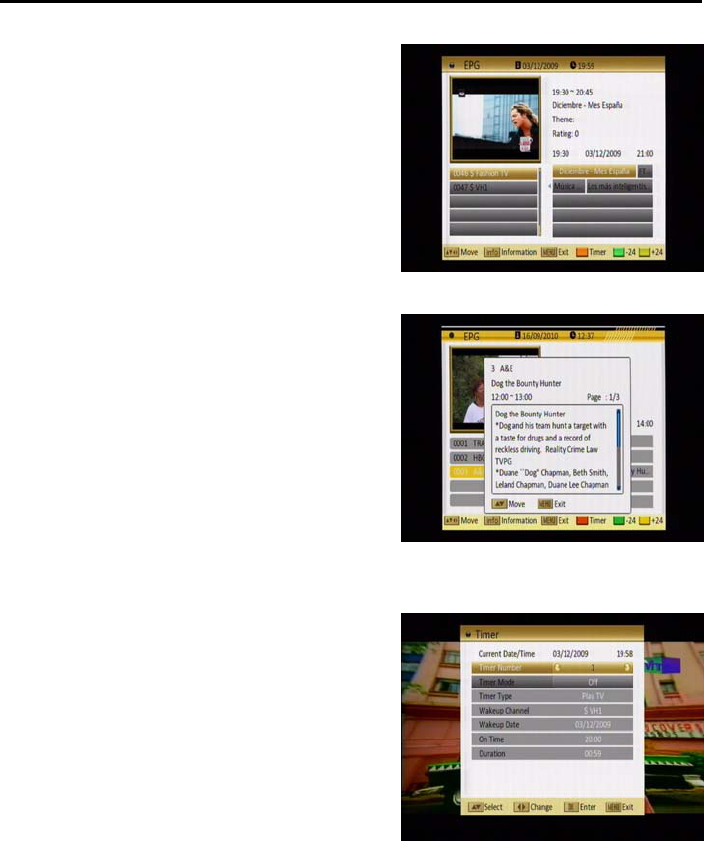
11
Basic Operation
Press the [GUIDE] button to display the
Electronic Program Guide.
NOTE: When in this menu, use the color
buttons on your remote control to
correspond to the color coded function (for
example, the Green-Time feature is
accessed by pressing the Green-GUIDE
button on your remote).
1. Press the RED button on the remote
control, which corresponds to the RED
(Time) command on the bottom of the
screen. You will then enter into the
following screen.
2. Use the [VOL◄/►] buttons to select the
chosen icon, then press the [OK] button to
set that action. Press the [EXIT] button to return to the original EPG screen.
3. Press the GREEN button on the remote
control, which corresponds to the GREEN
(Timer) command on the bottom of the
screen. You will then enter into the
following screen.
To navigate, press the [CH, VOL◄►]
buttons and set related date, as well start
time and duration. Using this Timer menu, you may set the Settop to tune your
desired channel (or tune and record) at a preset time. Save your settings by
highlighting ‘Save’ and pressing the [OK] button.

12
Basic Operation
2.9 CH ▲/▼
Press the [CH▲/▼] buttons to change the channel.
2.10 VOL ◄/►
Press the [VOL◄►] buttons to adjust the volume.
2.11 OK
1. Press the [OK] button to open the Channel List window. You can also select
your different “Favorites” groups by pressing [VOL◄/►].
2. Once you’ve selected the desired Channel / Favorites list, you can select
the desired channel by pressing the [CH▲/▼] buttons to highlight the channel,
then confirm it by pressing the [OK] button.
3. Press the [EXIT] button to return to normal TV viewing.
You may also use the [OK] button to direct tune a channel. First, enter the
desired Channel number using the remote control number keys, then press [OK]
to tune that channel.
You also use this [OK] button while setting features in the Settop Menu system.
2.12 MENU
Press the [Menu] button to enter or exit the current menu.
2.13 EXIT
Press the [Exit] button to exit the current menu. You may press this button to
escape any on screen display or function, including: ZOOM, INFO, GUIDE,
Channel List, etc..
2.14 PAUSE
1. Press the [PAUSE] button and the picture will be paused, but the sound of
the channel will still continue.
2. Press the [PAUSE] button again to return to normal viewing.
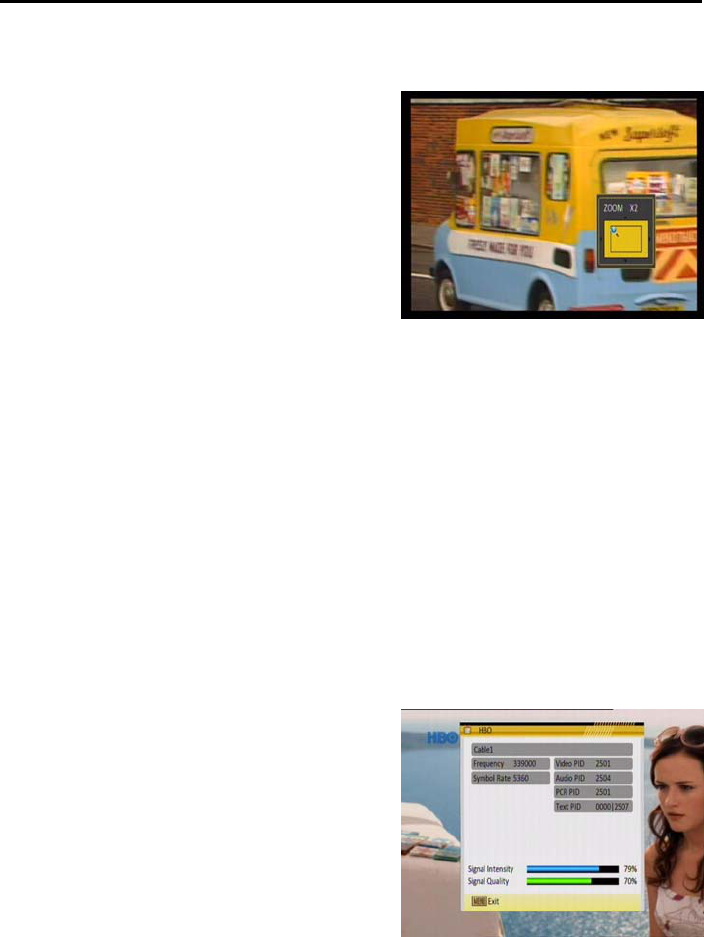
13
Basic Operation
2.15 ZOOM
1. The [Zoom] button allows you to
magnify the video. You may use this
button during normal viewing, or you
may press [PAUSE] and zoom a still
picture.
2. Press the [Zoom] button the first time
and you will see ‘ZOOM x1’ displayed
in the lower right corner of the TV
screen. Press [ZOOM] again and the
image will enlarge to ‘ZOOM x2’. Press [Zoom] again, and repeat until
you reach the desired magnification (Zoom has the following possible
magnification settings: x1, x2, x4, x6, x8, x12, x16).
3. In “x2 ~ x16” Zoom mode, use the [CH▲/▼ / VOL◄/►] buttons to move
the image center area to the portion of the video you want to view.
4. Press the [Exit] button to close the “Zoom” window.
*You may also use this [PGUP / ZOOM] button when in the GUIDE to quickly
page up thru the available channels.
2.16 INFO
In TV mode, press [INFO] button can open
information screen, in the window shows
the parameters of current channel.
Two dynamic bars at the bottom of the
window reflect the signal intensity and
signal quality of the current channel.
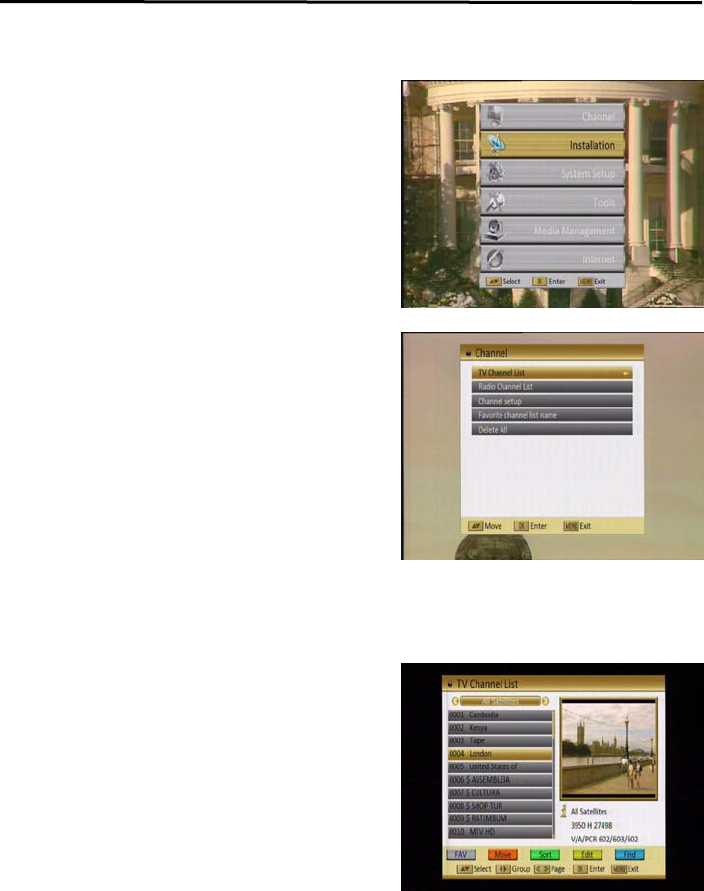
14
Menu Operations
3. Channel
Press [Menu] in the TV/radio mode to enter
the main menu.
1. Press [CH▲/▼] to select the channel
item.
2. Press [OK] to enter the selected item.
In the channel menu:
Press [CH▲/▼] to select the wanted menu
item among TV Channel List, Radio
Channel List, Channel setup, Favorite
group list name and Delete All.
Press [OK] to enter the selected item.
3.1 TV Channel List
If you enter the channel list menu a window
like the one below will open.
1. You can move the highlighted channel
with [CH ▲/▼] and press [OK] to
preview the highlighted program in the
preview window.
2. Press [PGUP/PGDN] on the RCU to
jump between the channels by pages.
3. Press [Vol◄/►] to switch satellite of
the program group.
4. Press [Menu] or [Exit] buttons to enter TV playing mode.
5. The color buttons offer further functions to manage the channel list.
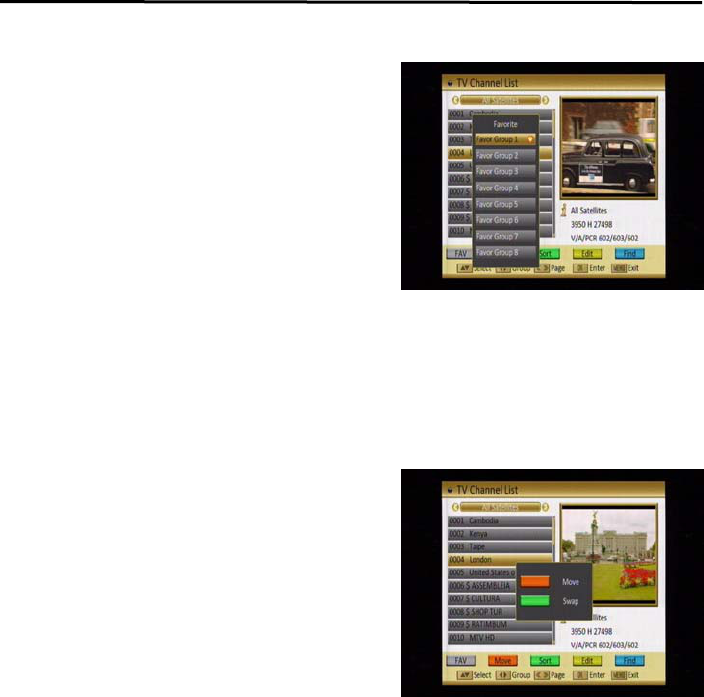
15
Menu Operations
3.1.1 Favorite
1. Press [FAV] to open the favorite
window.
2. You can select between 32 favorite
groups with [CH▲/▼]. Press [OK] to
assign the channel to a favorite group,
press [EXIT] to exit favorite group.
3. Press [OK] again to remove the
channel from the marked favorite
group.
4. Press [MENU] button you will be asked “Are you sure to save?”. Select
“Yes” to save the marked favorite group. Select “No” to cancel the operation.
5. To return to the TV channel list. The channels of favorite groups are
indicated with a favorite icon behind the name.
3.1.2 Move
Pressing the [Red] button in the TV channel
list will open another window where you
can choose between move the actual
channel and swap the actual channel to the
desired position, press [OK] to confirm it.
a) Move
1. Press [Red] button to show a moving
icon behind the channel name.
2. Move the channel to the desired
position with [CH▲/▼]. Press [OK] to confirm the position.
b) Swap
1. Press [Green] button to show a moving icon behind the channel name.
2. Move the channel to the desired position with [CH▲/▼]. Press [OK], then
the selected channel will exchange the positions with the channel name on
this position immediately.
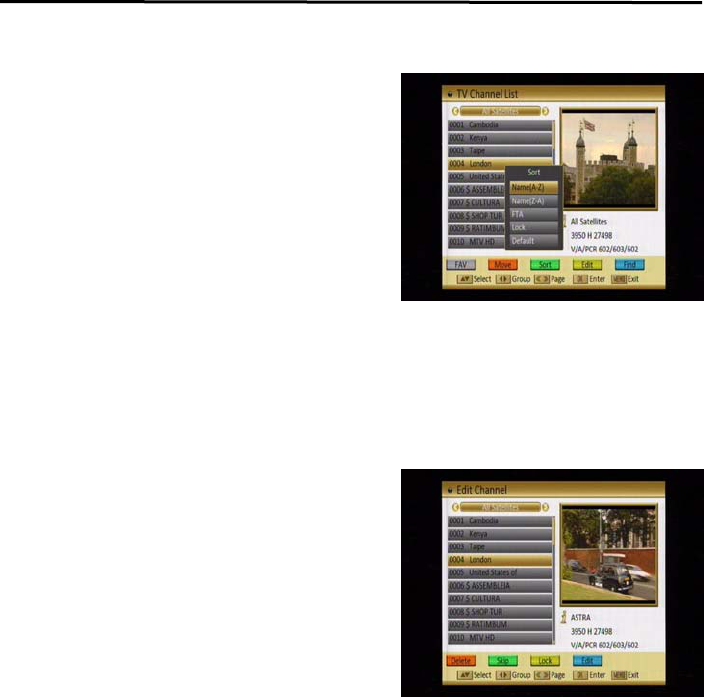
16
Menu Operations
3.1.3 Sort
Press [Green] to open the sort window.
Press [CH▲/▼] to select and [OK] to
confirm your choice.
The ways of sorting are:
Default: Sort channel factory default.
FTA/CAS: Sort channel by free and
scrambled sequence. Free channels
will be listed first and scrambled
channels behind in the channel list.
Lock: Unlocked channels are listed first end locked channels at the end.
Name (A-Z): Sorting in Alphabetical order, ignoring “$” symbol.
Name (Z-A): Sorting in Alphabetical order, ignoring “$” symbol.
3.1.4 Edit
After pressing the [Yellow] button a window
for entering the password will open. The
default password is “0000”.
You can delete, skip, lock and edit the
channel.
Press [MENU] to leave the channel editing.
The system will ask you to confirm the
saving of the changes you made.
3.1.4.1 Delete
In channel edit menu press [Red] button will open another window where you
can choose between delete one channel and delete all channel.
Del One
Press [Red] button to mark a channel for deleting. Marked channel will be
deleted after you confirm to save the changes when you leave this menu.
Del All
a) Press [Green] button to show a deleting icon behind all channel name.
b) Press [MENU] button you will be asked “Are you sure to save?”. Select
“OK” to delete all channel. Select “Cancel” to cancel the operation.
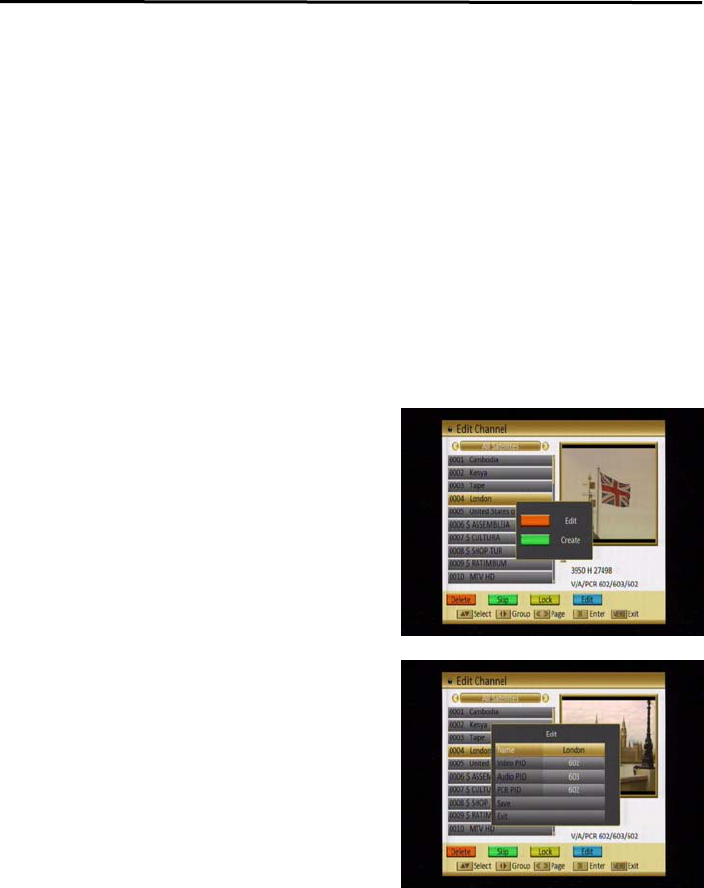
17
Menu Operations
3.1.4.2 Skip
In channel edit menu, press [Green] button to place a skip icon behind the name
of the highlighted channel. Marked channels will be skipped when you change
channels in TV mode after you confirm to save the changes when you leave this
menu.
3.1.4.3 Lock
In channel edit menu, press [Yellow] button to place a lock icon behind the name
of the highlighted channel. Marked channels will be locked and displayed only
after password has been entered if you confirm to save the changes when you
leave this menu.
3.1.4.4 Edit
Pressing the [Blue] button in the TV
channel list edit menu will open another
window where you can choose between
edit the actual channel and create a new
channel.
Edit
Press [Red] button to edit the channel.
1. Selecting the name item with [OK]
will display a button pad to show
you how to edit the channel
name.
2. On the “Video PID”, “Audio PID”
and “PCR PID” items you can
input numbers to modify the
item’s value.
3. After modification select “Save”
and press [OK] button to save the
modified values and exit “Edit”
mode. Or select “Exit” and press [OK] to leave edit mode without
saving the modifications.
Create
Press [Green] button to open the create channel window.
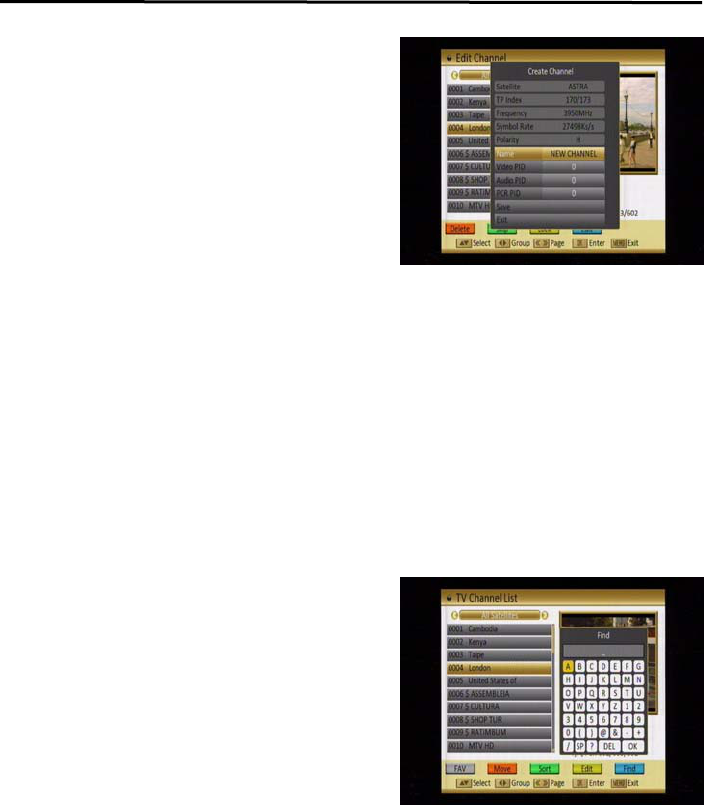
18
Menu Operations
1. Press [OK] on the “Satellite” item to
display the satellite list. You can select
the satellite for which you want to
create a new channel.
2. With marked “TP Index” item press
[OK] to display TP list, use [CH▲/▼]
to select for which you want to create
a new channel. Press [OK] to display
the TP number where the channel can
be found. The next three items will show the related parameters.
3. Highlight the “Name” item and press [OK] to display the button pad and edit
the new channel’s name. In “Video PID”, “Audio PID” and “PCR PID” items
you can enter the numbers directly to set these parameters of the new
channel.
4. After modification select “Save” and press [OK] to save the new channel
and leave the edit mode. Select “Exit” and press [OK] to exit the edit mode
without saving the new channel.
3.1.5 Find
1. Press [Blue] button to open the “Find”
window like showed beside. Press
[CH▲/▼] / [Vol◄/►] to select the
leading character of the channel name
and press [OK] to confirm it.
2. After entering the character(s)
highlight “OK” in the window and press
[OK] on the RCU.
3. Press [Exit] button to close the find
window and brings you back to the channel list.
3.2 Radio Channel List
Basically the operation of “Radio Channel List” is same as “TV Channel List”,
except that in the small channel window the radio Logo will be displayed.
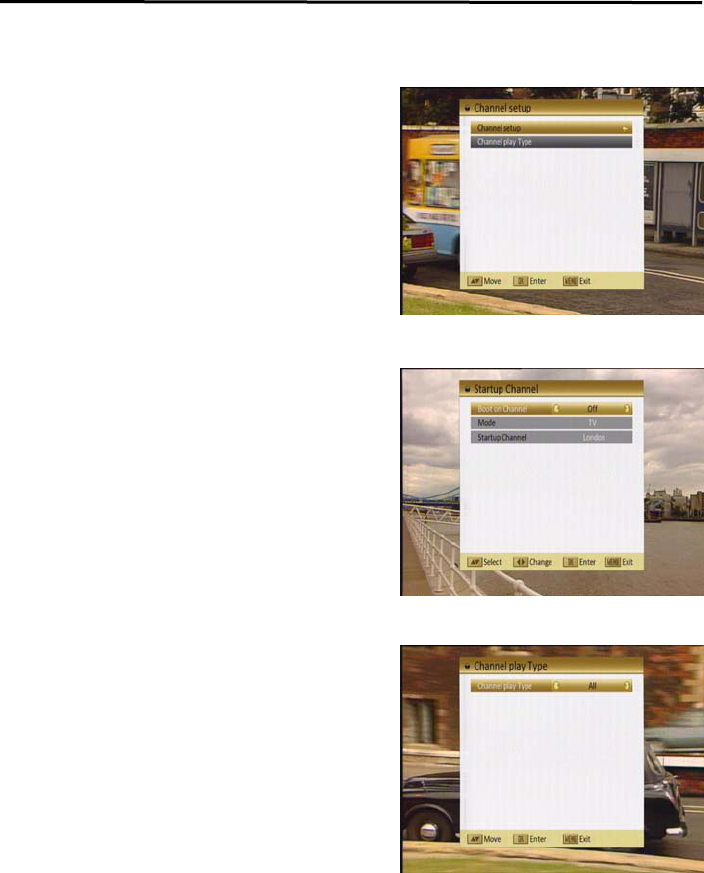
19
Menu Operations
3.3 Channel Setup
When you enter the “Channel Setup” menu
you will see a screen like beside:
1. Startup Channel: Press [OK] to enter
“Startup Channel” menu to see the
screen like showed beside:
If you set of “Boot on Channel” to
“On” you can edit the following
two items. If the setting is “Off”
the box always starts with the
channel that was running when the box has been switched off.
On the “Mode” item you can
select either “TV channel” or
“Radio channel”.
On “Startup Channel” item you
can open the channel list by
pressing [OK]. Then you can
select the channel of you choice.
Press [OK] again to confirm.
2. Channel Play type: Use [CH▲/▼] to
select, press [OK] to enter “Channel Play Type” menu. Here you can select
the “playing channels” as “All”, “Free”
or “Scrambled” with [Vol◄/►].
3. If you select “Free” then all scrambled
channels will be skipped when you
change channels with [Vol◄/►].
4. Press [Exit] to leave the “Channel
Setup” menu.
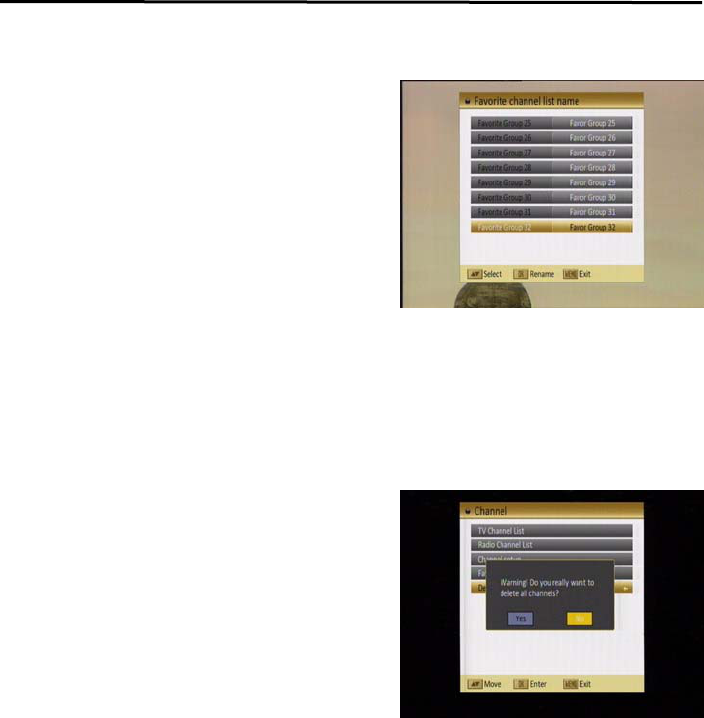
20
Menu Operations
3.4 Favorite group list name
When you enter “Favorite group list name”
menu with 32 favorite group will be
displayed, press [OK] on the RCU to
rename favorite group. Use [CH▲/▼] /
[Vol◄/►] to select character, press [OK] to
confirm it.
After modification select “OK” of button bar
and press [OK] on the RCU to rename the
favorite group name and leave the edit
mode. Press [Exit] on the RCU to exit the edit mode without saving the favorite
group name.
3.5 Delete All
To delete all channels:
1. Enter the password. The default
password is “0000”.
2. After entering the password correct a
safety question will show up where
you have to confirm first
3. Select “OK” to delete all channels or
“Cancel” to cancel the operation and
confirm with [OK].
4. In step 1 and step 2, pressing [Menu]
will exit the function directly without saving.
? Frequently Asked Question
Q: IF I incautiously delete all channels, what should I do?
A: there are two ways to restore:
To research all channels in the “Installation” menu.
Use “Factory Default” function to restore all channels in the “Tools” menu.
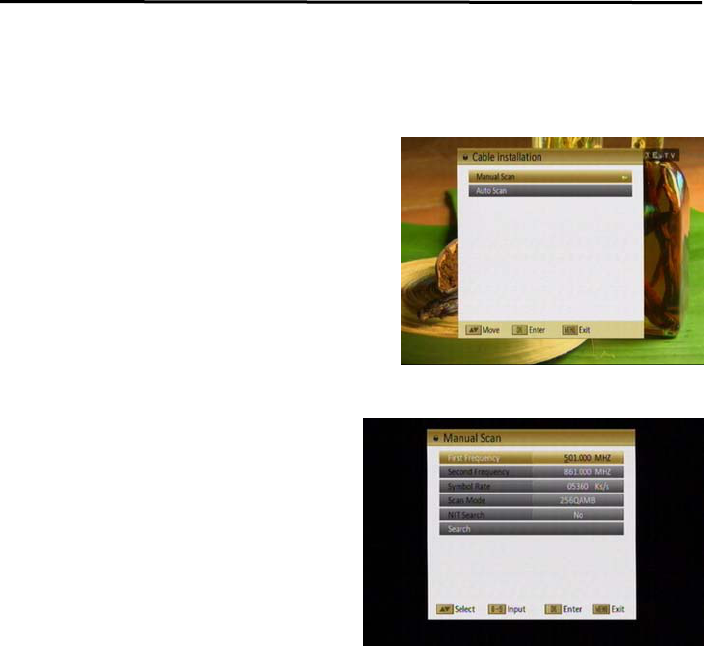
21
Menu Operations
4. Cable Installation
When you enter to “Cable Installation” menu, there will display the screen like
right:
In “Installation” menu;
1. Press [▼/▲] key to select menu
pages among Manual scan and Auto
Scan.
2. Press [OK] key to enter the selected
item.
4.1 Manual scan
When you enter to “Manual scan”
menu, there will display the screen like
right:
1. You have to set the parameters of
“First Frequency”, therefore use
the number buttons of the RCU.
2. You have to set the parameters of
“Second Frequency”, therefore
use the number buttons of the
RCU.
3. You have to set the parameters of “Second Frequency”, therefore use the
number buttons of the RCU.
4. You have to set the parameters of “Scan Mode”, therefore use the number
buttons of the RCU.
5. NIT Search: Press [Vol◄/►] to switch this function “Yes” or “No”.
6. Moving the highlight to “Search” item and press [OK] key to start scanning.
7. In the “Manual scan” menu, press [Exit] key to draw back from the
scanning.
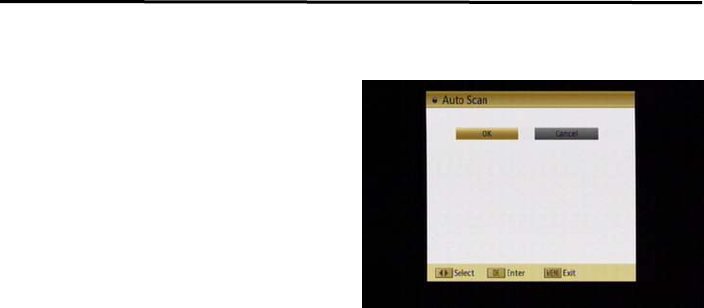
22
Menu Operations
4.2 Auto Scan
When you enter to “Auto Scan” menu,
there will display the screen like right:
1. Moving the highlight to “OK” item
and press [OK] key to start
scanning.
2. Moving the highlight to “Cancel”
item and press [OK] key to draw
back from the scanning.
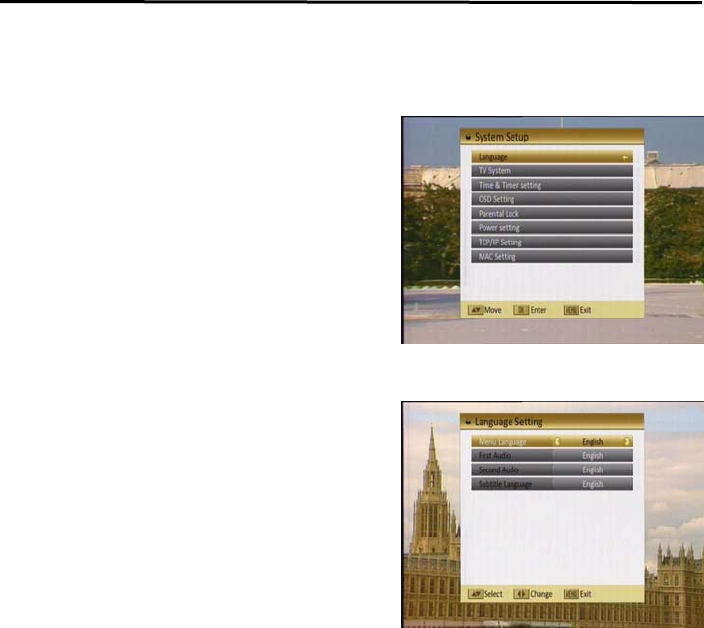
23
Menu Operations
5. System Setup
When you open the “System Setup” menu a window like the one beside will be
opened.
In “System Setup” menu:
1. Press [CH▲/▼] to select menu items
among Language, TV System, Time &
Timer setting, OSD Setting, Parental
Lock, Power setting, TCP/IP Setting
and MAC Setting.
2. Press [OK] to open the selected item.
5.1 Language
After selecting the “Language” menu you
will see a window like beside:
1. Menu Language: Press [Vol◄/►] to
select languages. The selection of
language include: English, German,
French, Spanish, Italian, Portuguese,
Turkish, Polish, Russian, Danish,
Greek, Hungarian, Arabic, Farsi and
Dutch.
2. First Audio: Some channels offer more than one audio language. This
function allows you to set the preferred audio language for those channels.
If a channel offers the same audio language as the “First Audio” you set the
system will play this audio language as default. If the channel does not
offer this audio language then the system will compare the offered
languages with the second audio language. The selections of audio
language include: English, German, French, Spanish, Italian, Portuguese,
Turkish, Polish, Russian, Danish, Greek, Hungarian, Arabic, Farsi and
Dutch.
3. Second Audio: If the channel has no audio language that corresponds with
“First Audio” but with “Second Audio” the system will play the second audio
language as default. If no audio language corresponds with the “Second
Audio” then the default language of the current channel will be played
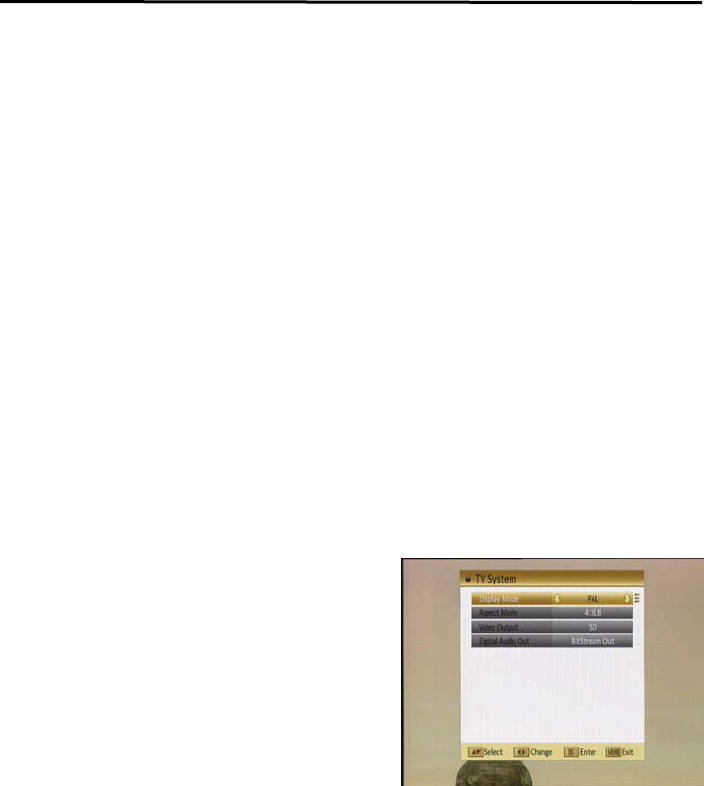
24
Menu Operations
instead. The selections of audio language include: English, German,
French, Spanish, Italian, Portuguese, Turkish, Polish, Russian, Danish,
Greek, Hungarian, Arabic, Farsi and Dutch.
4. Subtitle Language: In “OSD Setting”menu, use [Vol◄/►] to select “On” or
“Off”. If the current channel has subtitle information, it will be displayed if
this function is “On”. If this function is “Off” subtitles won’t be displayed. The
selections of subtitle language include: English, German, French, Spanish,
Italian, Portuguese, Turkish, Polish, Russian, Danish, Greek, Hungarian,
Arabic, Farsi and Dutch.
5. Teletext: Press [Text] button in TV mode to open the teletext page. This
service is depending on the support of the channel provider. If the channel
does not support teletext information, it will show “No Teletext Data” on the
screen. The selections of teletext language include: English, German,
French, Spanish, Italian, Portuguese, Turkish, Polish, Russian, Danish,
Greek, Hungarian, Arabic, Farsi and Dutch.
6. Press [Menu/Exit] to return back from “Language” menu.
5.2 TV System
When you enter the “TV System” menu you
will see the screen like below:
1. Display Mode is used to switch the
display mode. In SD Mode, You can
select from PAL / NTSC / Auto. In HD
Mode, You can select from Auto / 576I
/ 480I / 576P / 720P_50 / 1080I_25 /
720P_50 1080I_30. Press [Vol◄/►] to
switch the desired mode.
2. Aspect Mode is used to switch the screen aspect ratio mode. You can
select the needed mode from Auto / 4:3 PS / 4:3 LB / 16:9 with [Vol◄/►].
3. Video output is use for switching the screen aspect ratio mode. Now we
provide below options: HD / SD. You can press [Vol◄/►] key to select
each mode circularly.
4. Digital Audio Out is used to switch the output audio mode. You can select
the needed mode from LPCM Out / BS Out with [Vol◄/►].
5. Press [Menu/Exit] to return to the previous menu.
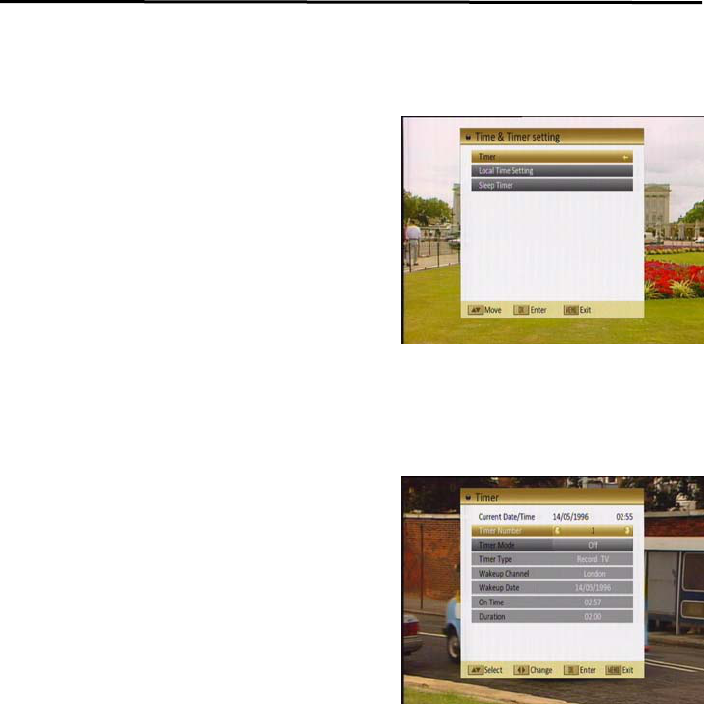
25
Menu Operations
5.3 Time & Timer Setting
When you enter “Time & Timer Setting” a menu with this 3 items will be opened.
1. Timer: Select “Timer” item and press
[OK] to enter the “Timer” menu.
You can press [CH▲/▼] to select
item.
The current time will be displayed
in the first column. If the current
time is incorrect, please modify it
with the [Number] buttons.
Timer Number: You can press
[Vol◄/►] to switch the timer number. There are totally 16 timers.
Timer Mode: Select how often the timer is running: Once, Daily, Weekly,
Monthly and Yearly, or switch the timer to off.
Timer Service: Select between TV Channel, Radio Channel and
Message.
When you select “TV Channel /
Radio Channel”(timer setting for
channel change and Wakeup
channel / date) then you have
further options you need to set:
Wakeup Channel: Press [OK] to
enter the channel list, and
select the channel you want to
see with [CH▲/▼], press [OK] to confirm it.
Wakeup Date: Use number buttons to input your wakeup date.
On Time: Use number buttons to input your wakeup time. If date and
time are reached then no matter if the system is in standby mode
or in playing mode, it will automatically switch to the channel you
set and start to play.

26
Menu Operations
Duration: Here you can set the time you want to see or play this
channel. When the time is reached, whenever the system is in
standby mode or playing a channel, the system will automatically
switch to the channel you select and play the channel within the
duration time you set. The minimum duration unit is one minute.
After the duration time, the system will automatically switch to
Standby mode.
When you select “Message”(reminding message) option in “Timer
Service” then you can enter additional data:
Wakeup Message: Press [Vol◄/►] to select the category
of the wakeup message from Birthday, Anniversary and General.
Wakeup Date: Use the [Number] buttons to input your wakeup
date.
On Time: Use the [Number] buttons to input your wakeup time. If
date and time are reached, no matter if the system is in standby
mode or in playing mode, it will automatically show a reminding
message. The message will be displayed on the screen until you
press [Exit] to close it.
Duration: Here you can set the time you want to see or play this
channel. When the time is reached, whenever the system is in
standby mode or playing a channel, the system will automatically
switch to the channel you select and play the channel within the
duration time you set. The minimum duration unit is one minute.
After the duration time, the system will automatically switch to
Standby mode.
Press [Exit] to leave the “Timer” menu.
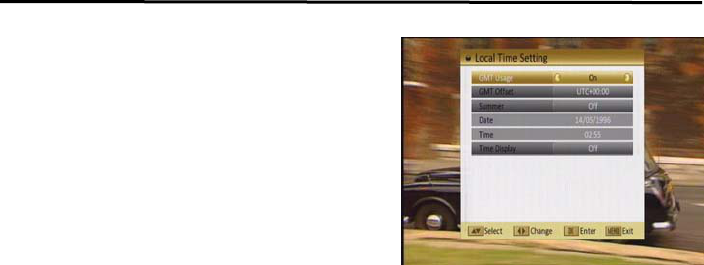
27
Menu Operations
2. Local Time Setting: When you select
“Local Time Setting” and press [OK]
then you will see a window like the one
beside:
GMT Usage: This item is used to
set the time by using the time
signal from the satellite. Press
[Vol◄/►] to change the setting.
The “GMT Offset” item is only
available when “GMT Usage” is set to “On”. Press [Vol◄/►] to set the
“GMT Offset” value. With every time you press the button the time
offset will be increased /decreased by half an hour.
Summer: Press [Vol◄/►] to switch this function “On” or “Off”.
“Date” and “Time” items are only available when the “GMT Usage” is
set to “Off”. Press [Vol◄/►] to select one item and use number
buttons to input time and date directly.
Time Display: Press [Vol◄/►] to switch this function “On” or “Off”.
NOTE: If the current channel provides the correct time information,
you will see the current time after you entered “Local Time Setting”
menu. If the channel doesn’t provide time information, you have to
input the date and time information manually. The most channels
support the time signal.
Press [Exit] to leave the “Time” menu.
3. Sleep Timer: Select “Sleep Timer” item and press [OK] to set the sleep
timer. You will see “Sleep timer OFF / Sleep timer 10 / Sleep timer 30 /
Sleep timer 60 / Sleep timer 90 / Sleep timer 120”.
If you set a sleep time, the system will change to standby mode after the
chosen time period.
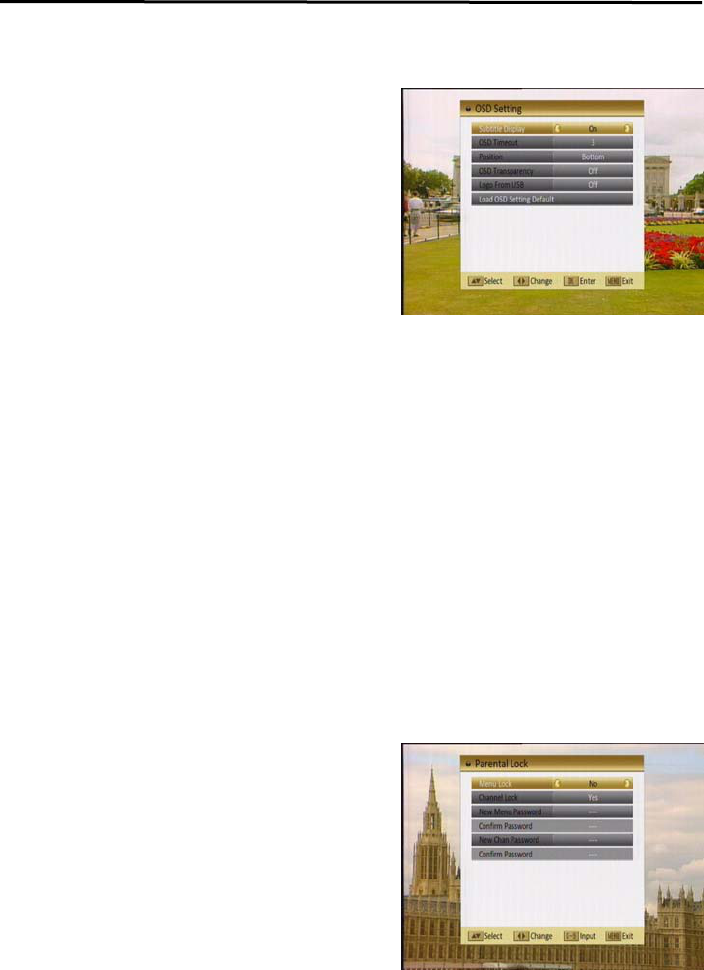
28
Menu Operations
5.4 OSD Setting
When you select “OSD Setting” you will see
a screen like beside:
1. Subtitle Display: Press [Vol◄/►] to
select “Off”, “Standard” or “Teletext
Subtitle”. If the current channel has
subtitle information, it will be displayed
if this function is “Standard” or
“Teletext Subtitle”. If this function is
“Off” subtitles won’t be displayed.
2. OSD Timeout: This setting determines the duration the info window is
displayed on the screen when you change channels. Press [Vol◄/►] to set
the time between 1 to 10 seconds.
3. Position: Press [Vol◄/►] select the position between top and bottom.
4. OSD Transparency: With this parameter you can set the transparency of
the menus. Press [Vol◄/►] select the value between 10%, 20%, 30%,
40% and “Off”(means no transparency function).
5. Logo From USB: Press [Vol◄/►] to select “Off” and “On”. Set the image as
background.
6. Load OSD Setting Default: If you want to reset your OSD settings to the
default settings then select this item and press [OK].
7. Press [Exit] button to leave the “OSD Setting” menu.
5.5 Parental Lock
You can set a password for anyone who
wishes to operate the “Installation” menu.
You can also set the password to lock
channels. Below you find how to set and
change the password.
1. On “Parental Lock” press [OK] to open
a dialogue box and input the password.
After you entered the correct password,
you will see a screen like beside:

29
Menu Operations
2. Menu Lock: If Menu Lock is set to “Yes” then you need to enter the
password every time you want to open the menu. If set to “No” then you
can open the menu without entering the password first.
3. Channel Lock: If set to “Yes” then you need to enter the password before
you can see those channels which have been marked as locked channels
in the channel menu. If set to “No” then even those channels can be
selected without entering the password first.
4. New Menu Password: Here you can change the existing password. You
should do this after you set up the receiver the first time and every time
when you think that your password is known by unauthorized persons. To
change the password enter the new password in the “New Menu
Password” item and repeat the same one in the “Confirm Password” item.
If the passwords are not identically then you will see a warning message. If
you entered the same new password in both fields then you will see the
message “Saving Data, Please Wait…”. From now on you need to use the
new password to open locked menus or locked channels.
NOTE: The default password is 0000.
5. Basically the operation of “New Chan(channel) Password” is same as “New
Menu Password”.
6. Press [Exit] to leave the “Parental Lock” menu.
5.6 Power setting
When you select this option, you will see a
screen like beside:
1. Automatic Standby: press [OK] to
open the “Automatic Standby” menu.
Automatic Standby: Press
[Vol◄/►] to select “Off” and “On”.
Time: Press [Vol◄/►] to select
“1hr” ~ “8hr”.
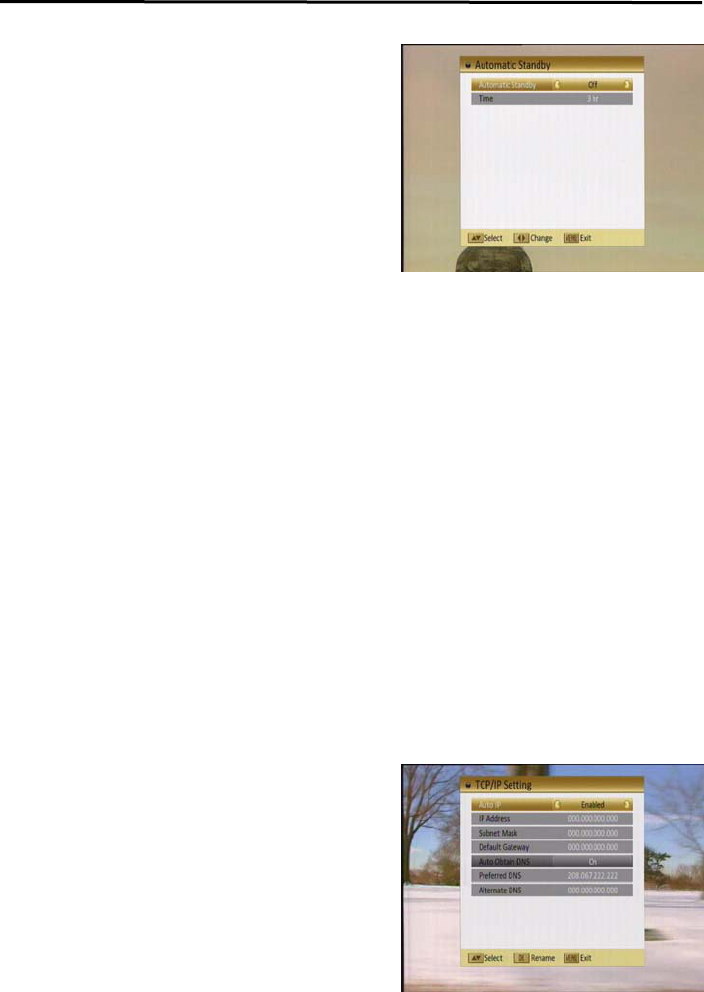
30
Menu Operations
2. LNB Power: If your receiver is
connected to the LNB directly then you
need to set the LNB Power to “On”. If
your receiver is connected to a multi
switch (SMATV signal distribution
system) then it may be that you don’t
need to provide the power to the LNB.
But since this is depending on the kind
of installed distribution system we
recommend you to contact your installer or to refer to the user manual of
this system to get the correct information.
You also just can change this setting and check if you still can receive the
channels. If the LNB Power is off and you still can see all channels then we
recommend this setting.
3. Low Power Consumption: At this option, you could Enable / Disable the low
power consumption mode. This mode allows saving current consumption
when the receiver is stand-by.
Low power consumption mode only can be enabled when the VCR
Loopthrought option (see point 5.2.) is Settop master selected. By the other
way, if you choose VCR master, then the Low Power Consumption option
will not be active and the receiver will not be in LPC mode.
4. Press [Exit] button to leave this menu.
5. Press [Exit] button to leave this menu.
5.7 TCP/IP Setting
1. The Settop must be switched off.
Please connect your Settop with the
Internet-Router via the Ethernet Cable
(RJ45) (not part of the delivery).
2. Switch Settop power on.
3. Enter into the main menu and User
Options, also Select “TCP/IP” setting
and confirm with [OK].
4. To navigate in this menu please use
V, V and [OK].
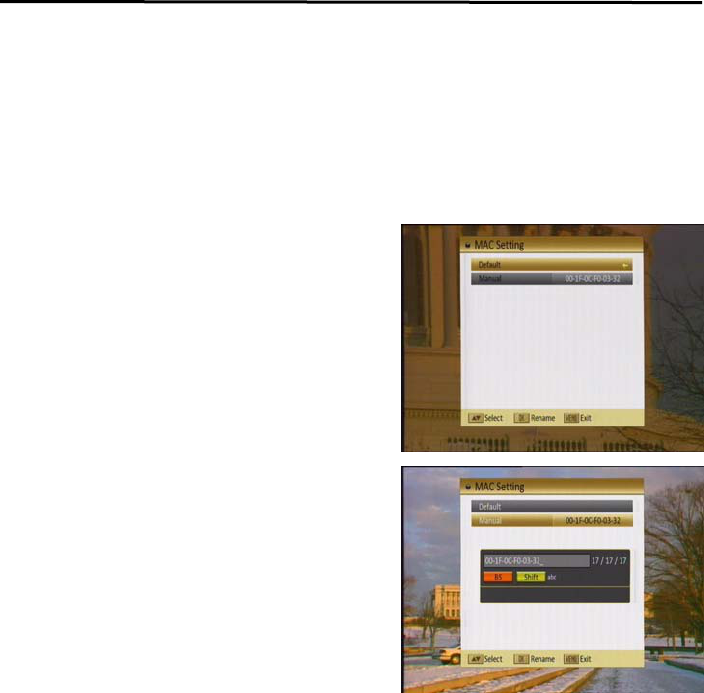
31
Menu Operations
5. Enable (Auto IP) and move to [MENU] to confirm with [OK].
6. In case you want to setup your Network manually, please disable Auto IP
[disabled] and set the required parameter by using the number buttons on
your remote control, move to [MENU] to confirm with [OK].
5.8 MAC Setting
When you select MAC Setting, you will see
a screen like beside:
1. When you select Default, then all
changes you made will be reset to
default values.
2. Manual: Press [OK] and you will see
below menu.
You can enter the number, the
RCU to select character.
Press [Red] button will delete the
character.
Press [Yellow] button will shift the
character.
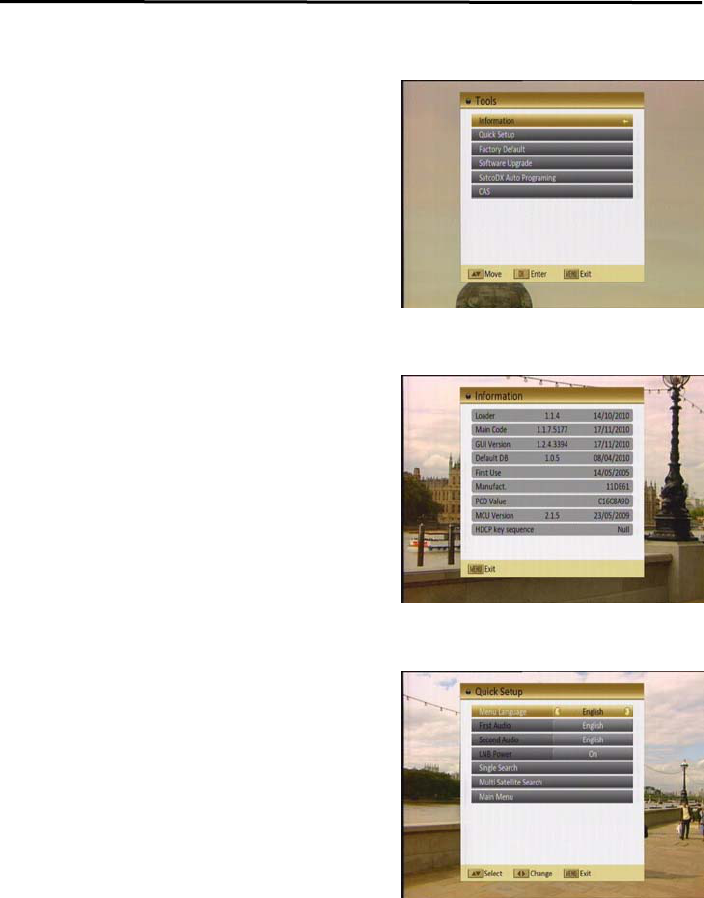
32
Menu Operations
6. Tools
When you enter to “Tools” menu, you will
see a screen like beside:
In “Tools” menu:
1. Press [CH▲/▼] to select the wanted
item among Information, Quick Setup,
Factory Default, Software Upgrade,
SatcoDX Auto Programming and CAS.
2. Press [OK] to enter the selected item.
6.1 Information
1. When you select the “Information”
menu you will see a screen like beside.
The screen displays data about the
current channel.
2. Press [Exit] button to leave the
information display.
6.2 Quick Setup
When the Settop is used, which need to
repeat set menu Language, First
Audio, Second Audio, LNB
Power, LNB2 Power, Single
Search, Multi Satellite Search
and Main Menu.
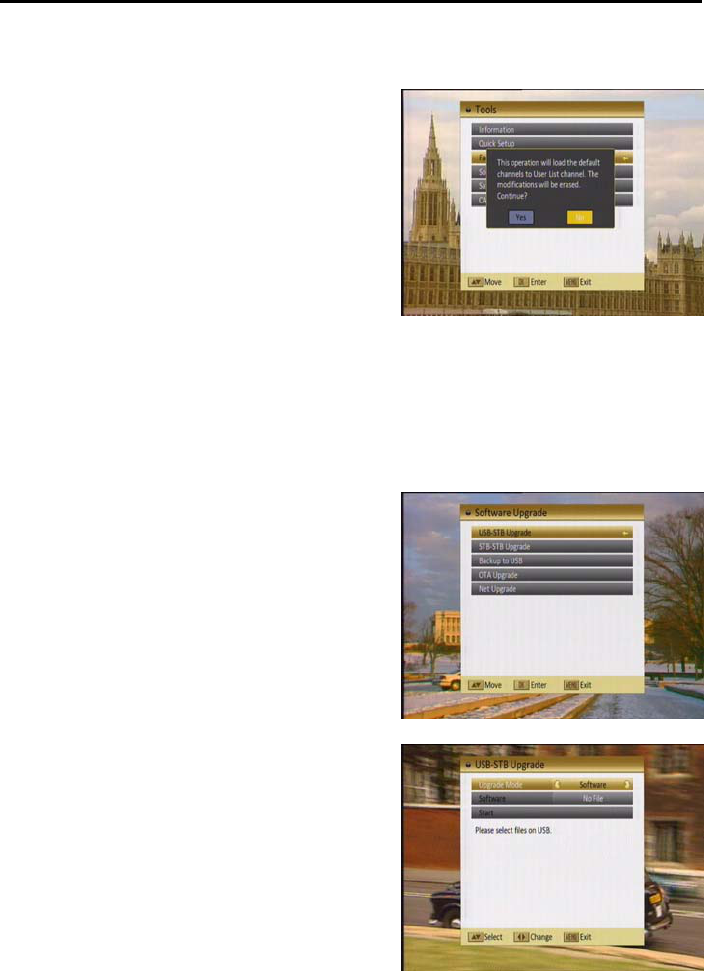
33
Menu Settings
6.3 Factory Default
When you press [OK] on the “Factory
Default” item:
1. A dialogue box will occur where you
need to enter the password.
2. After you input the correct password a
warning message will be displayed like
the one beside.
3. If you select “Yes” then all changes
you made will be reset to default
values. Make sure you really want to do this!
4. Press [Exit] in both steps will close the window without resetting the
receiver.
6.4 Software Upgrade
When you enter to “Software Upgrade”
menu, you will see a screen like beside:
1. Press [CH▲/▼] to select the wanted
item among USB-STB Upgrade,
STB-STB Upgrade, Backup To USB,
OTA Upgrade and Net Upgrade.
2. Press [OK] to enter the selected item.
6.4.1 USB-STB Upgrade
This option allows updating the software of
the receiver with the received data from a
USB memory device. To do it, connect a
USB memory device to the receiver and
accede to this menu option.
The last software version to be loaded must
be placed at the root path of your USB
device.
1. Upgrade Mode: the mode of the
upgrade to be chosen, Press [Vol◄/►] to select Software, Whole, User
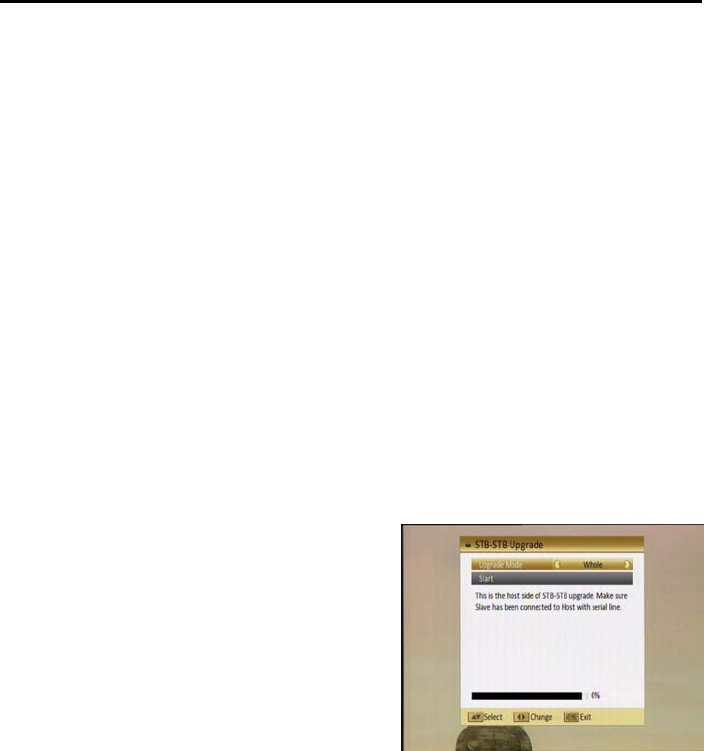
34
Menu Settings
Interface, Default DB, CAS and Ch.List & Setting.
2. In the “Software” item press [Vol◄/►] to select the file which you want to
scan or press [OK] to open the “USB list” to select directly with [CH▲/▼],
and press [OK] to finish the selection.
3. Start: Press [OK] to start upgrade.
4. Once the file has been loaded, it requires the conformity to end the
upgrading process, writing into the receiver “Are you sure to burn flash ?”.
Press [OK] to upgrade the receiver. In case during the reading of the file, it
is corrupted or it would be a not appropriated for this model of receiver, an
alert message would appear “Error reading the USB disk”.
5. After pressing [OK] the receiver will write into the Flash memory, and it will
reboot to end the upgrading process.
NOTE: The upgrade file is the binary file, *.bin. Only the files, which
extend name is bin, would be displayed. User need put the upgrade file
under root of USB card.
6.4.2 STB-STB Upgrade
This function allows you to upgrade the
software of the receiver. This can be done
from PC to receiver or from a master
receiver to a slave receiver.
1. Connect master receiver or PC to the
slave receiver via serial interface
(0-Modem cable). Enter the “Software
Upgrade” menu of the master receiver
and press [Vol◄/►] to change the
upgrade mode. Upgrade modes include: Software, Whole, User Interface,
Default DB, CAS and Ch.List & Setting.
2. Switch on the slave receiver.
3. Mark “Start” on the master reeciver and press [OK] to start upgrade.
Wait until the display on the front panel shows “-END”. Then switch off the
receiver and on again. Now the new software is used.
4. Press [MENU] to save the setting without upgrade.
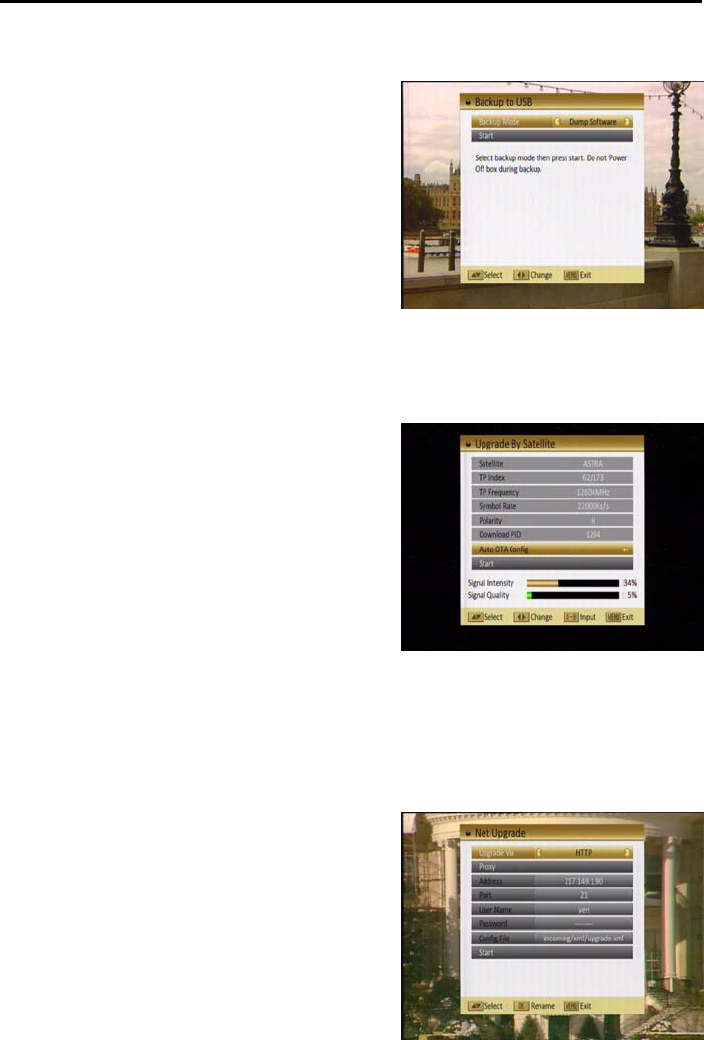
35
Menu Settings
6.4.3 Backup To USB
This function allows you Dump Software
and Ch.List & Setting fo the receiver to
external hard drives.
1. press [Vol◄/►] to change the backup
mode. backup mode include: Dump
Software and Ch.List & Setting.
2. Mark “Start” on the master reeciver
and press [OK] to start Backup.
3. Press [MENU/EXIT] to save the
setting without Backup.
6.4.4 OTA Upgrade
This function can upgrade the software of
your receiver through data sent by a
satellite. At the moment we offer satellite
updates only through ASTRA1 and Hotbird
satellites.
1. Select the satellite and TP or input the
TP value and download PID.
2. Then mark “Start” and press [Enter] to
begin the download of the upgrade.
This may need up to 60 minutes. Therefore we suggest using of this
function only if you don’t intent to watch TV during this time.
3. Auto OTA Config: The system could upgrade automatically in standby
mode.
6.4.5 Net Upgrade
After selecting “Net Upgrade” you will see a
window like beside:
Net upgrade supporting.
Follow below operate methods:
1. Select one computer as FTP or HTTP
server
2. Use create-bin.exe tool to create SW in

36
Menu Settings
computer, which used for STB upgrade.
3. Connect STB to Router, and then contact Router to computer.
4. Setting right Port, FTP use port 21, HTTP use port 80.
5. Setting right address, User name, Password in STB, which need meet
computer parameter.
6. At last, press ‘Start’ button to update SW from computer.
6.5 SatcoDX Auto Programming
This function is using the tables of the SatcoDX websites to update your
channel and satellite lists. You need a special application which is available on
the CD-ROM of the Tele-Satellite magazine. Install this software on your PC
first.
1. Start the SatcoDX application on your PC.
2. Select “SatcoDX Auto Programming” item from the “Tools” menu and press
[OK]. The screen will show the message “OK to Proceed”.
3. Press [OK] again and you will see the message “Ready to Download”.
4. In the PC application set the Baud Rate to 115200 and start the download
procedure.
! Caution:
The new download channels will delete the original channels list.
Please be careful before using it.
6.6 CAS
When you enter to “CAS” menu, you will see a screen like beside:
CA
In this option, you can find information
about the conditional access system. If
there is no card or it is placed incorrectly,
information about “No card” &“Unknown”
will be showed on the screen. With a
FELEC-CAS card, information about the
card will be showed.
Note: Card must be inserted with chip in
upper side.
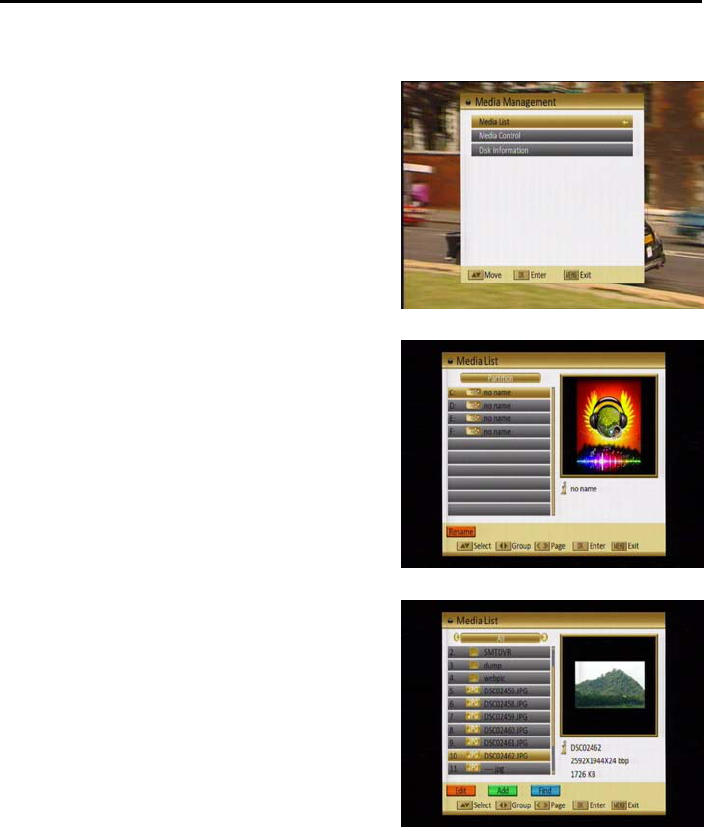
37
Menu Settings
7. Media Management
When you enter to “Media Management”
menu, you will see a screen like beside:
In “Media Management” menu:
1. Press [CH▲/▼] to select the Media
List, Media Control and Disk
Information.
2. Press [OK] to enter the selected item.
7.1 Media List
Press [CH▲/▼] to select the wanted item
partition.
Press [Red] button to open the “Rename”
window like showed beside. Press
[CH▲/▼] / [Vol◄/►] to select the leading
character of the channel name and press
[OK] to confirm it.
If you enter the Media List menu a window
like the one below will open.
1. Press [Vol◄/►] select the all, mp3,
image, video, music list, picture list,
video list, Record list.
2. You can move the highlighted Record
with [CH▲/▼] to preview the
highlighted program in the preview
window.
3. Press [PGUP/PGDN] on the RCU to jump between the channels by pages.
4. Press [Menu] or [Exit] buttons to enter TV playing mode.
5. The color buttons offer further functions to manage.
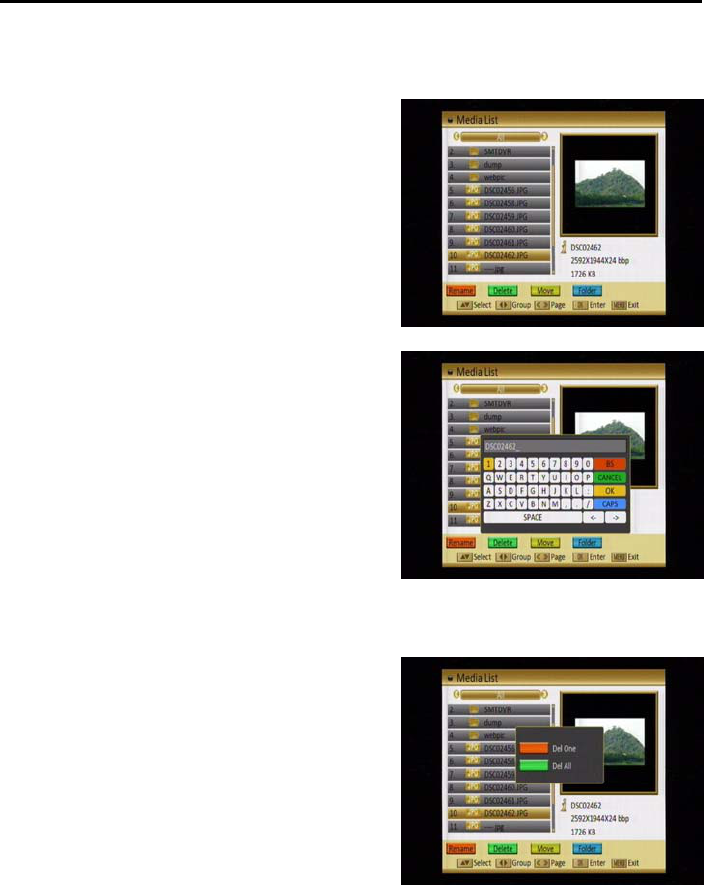
38
Menu Settings
7.1.1 All
[Edit]
Press [Red] button to open the “Edit”
window like showed beside.
The color buttons offer further functions to
manage.
1. Rename
Press [Red] button to open the
“Rename” window like showed beside.
Press [CH▲/▼] / [Vol◄/►] to select
the leading character of the channel
name and press [OK] to confirm it.
After entering the character(s)
highlight “OK” in the window and
press [OK] on the RCU.
Press [Exit] button to close the find
window and brings you back to the Record list.
2. Delete
In all edit menu press [Green] button will
open another window where you can
choose between delete one and delete all.
Del One
Press [Red] button to mark a “mp3 /
image / video”for deleting. Marked
“mp3 / image / video” will be deleted
after you confirm to save the changes
when you leave this menu.
Del All
a) Press [Green] button to show a deleting icon behind all “mp3 / image /
video” name.
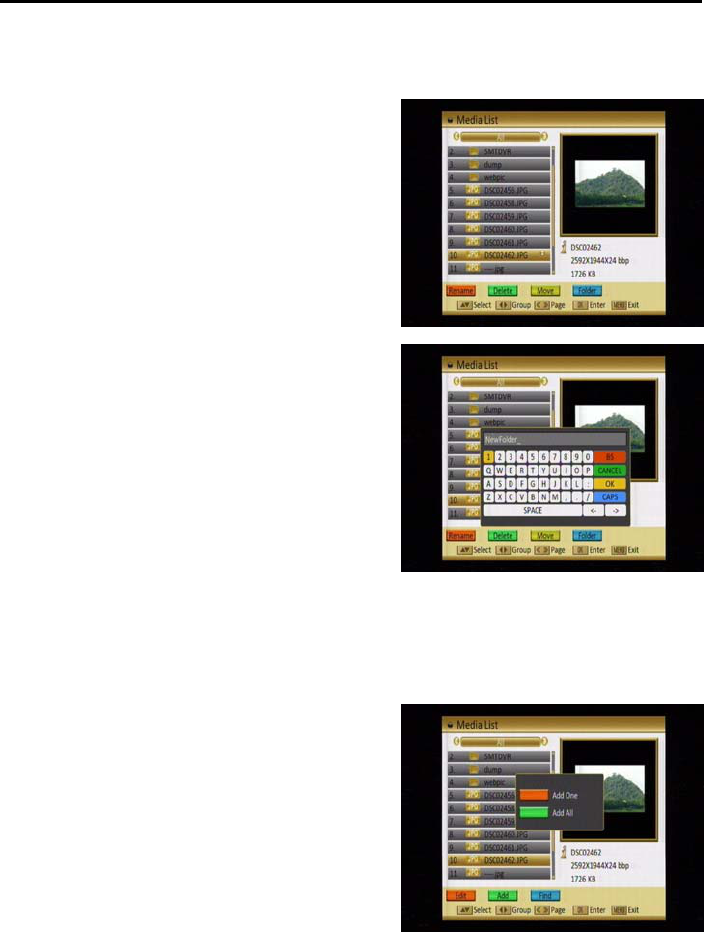
39
Menu Settings
b) Press [MENU] button you will be asked “Are you sure to save?”. Select
“OK” to delete all “mp3 / image / video”. Select “Cancel” to cancel the
operation.
3. Move
Press [Yellow] button to show a
moving icon behind the “mp3 / image /
video / folder” name.
Move the “mp3 / image / video / folder”
to the desired folder list with [CH▲/▼].
Press [OK] to confirm the position.
4. Folder
Press [Blue] button to open the “New
Folder” window like showed beside.
Press [CH▲/▼] / [Vol◄/►] to select
the leading character of the folder
name and press [OK] to confirm it.
After entering the character(s)
highlight “OK” in the window and
press [OK] on the RCU.
Press [Exit] button to close the find window and brings you back to the all
list.
[Add]
In all menu press [Green] button will open
another window where you can choose
between add one and add all.
Add One
Press [Red] button to mark a “mp3 /
image / video”for add. Marked “mp3 /
image / video” will be add after you
confirm to save the changes when you
leave this menu.
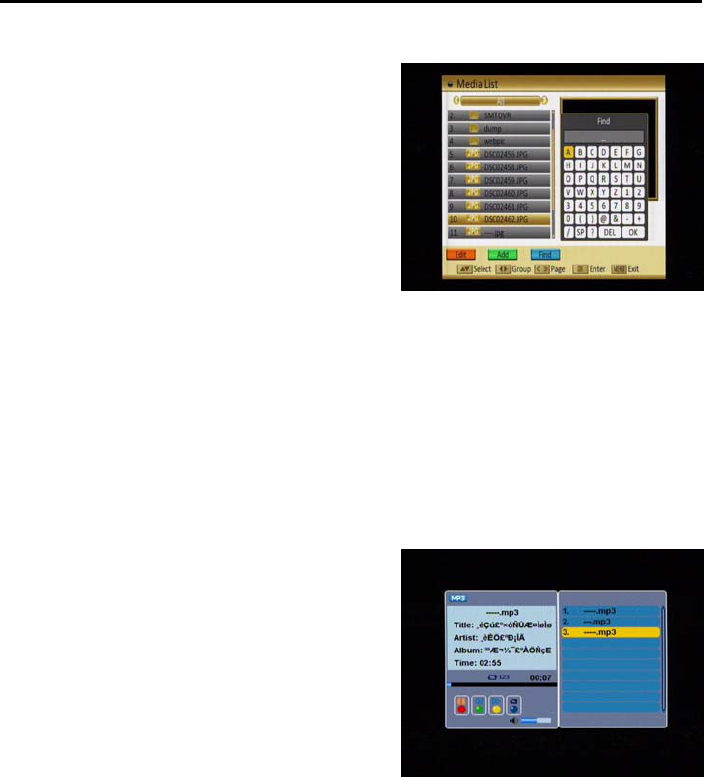
40
Menu Settings
Add All
a) Press [Green] button to show a
add icon behind all “mp3 / image /
video” name.
b) Press [MENU] button you will be
asked “Are you sure to save?”.
Select “OK” to add all “mp3 /
image / video”. Select “Cancel” to
cancel the operation.
[Find]
Press [Blue] button to open the “Find” window like showed beside. Press
[CH▲/▼] / [Vol◄/►] to select the leading character of the channel name and
press [OK] to confirm it.
After entering the character(s) highlight “OK” in the window and press [OK] on the
RCU.
Press [Exit] button to close the find window and brings you back to the all list.
[play]
The play offer further functions to manage.
If you enter the play menu a window like
the one below will open.
The color buttons offer further functions to
manage the channel list.
Red: When you play music program,
press [Red] will stop the program,
press [Red] again will play the
program continually.
Green: When you play music program, press [Green] button to back the
program fast.
Yellow: When you play music program, press [Yellow] button to fast forward
the program.
Blue: Change play mode by [Blue] Key, and play mode include: Sequential /
Random / Single repeat / all repeat.
Press [Exit] to return to the previous menu.
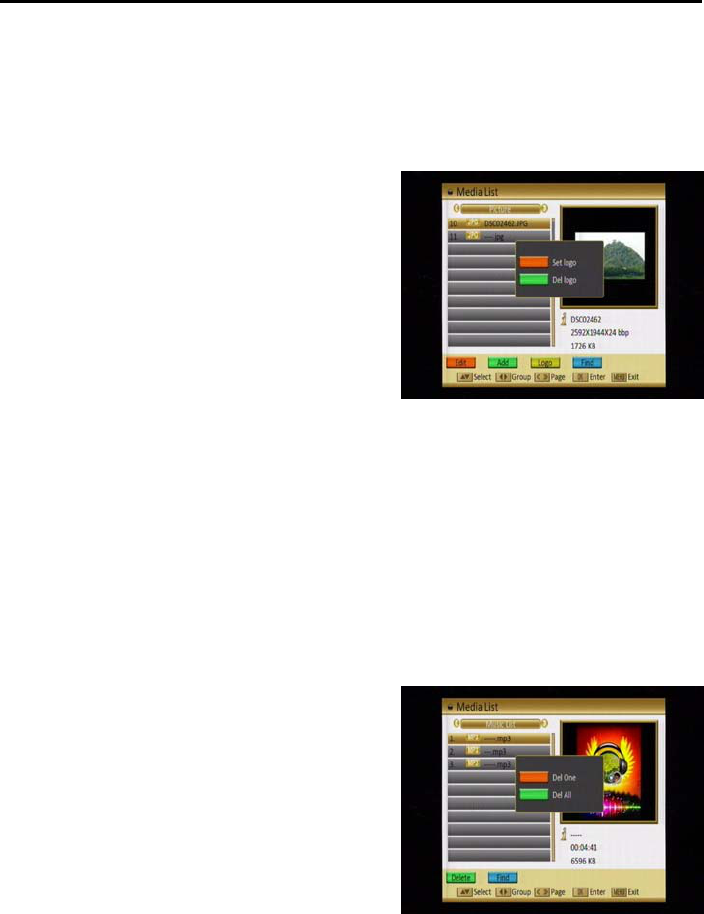
41
Menu Settings
7.1.2 Music
Basically the operation of “mp3” is same as “all”.
7.1.3 Picture
Basically the operation of “Picture” is same
as “all”, except that in the Yellow buttons
offer further functions to manage.
In image menu press [Yellow] button will
open another window.
press [Red] to set the image as
background.
press [Green] to delete the image as
background.
7.1.4 Video
Basically the operation of “video” is same as “all”.
7.1.5 Music List
The color buttons offer further functions to manage.
[Delete]
In media list menu press [Green] button will open another window where you
can choose between add one image and add all image.
Del One
Press [Red] button to mark a image
for add. Marked image will be add
after you confirm to save the changes
when you leave this menu.
Del All
a) Press [Green] button to show a
add icon behind all image name.
b) Press [MENU] button you will be
asked “Are you sure to save?”. Select “OK” to add all image. Select
“Cancel” to cancel the operation.
[Find]
Basically the operation of “Music List Find” is same as “all Find ”.
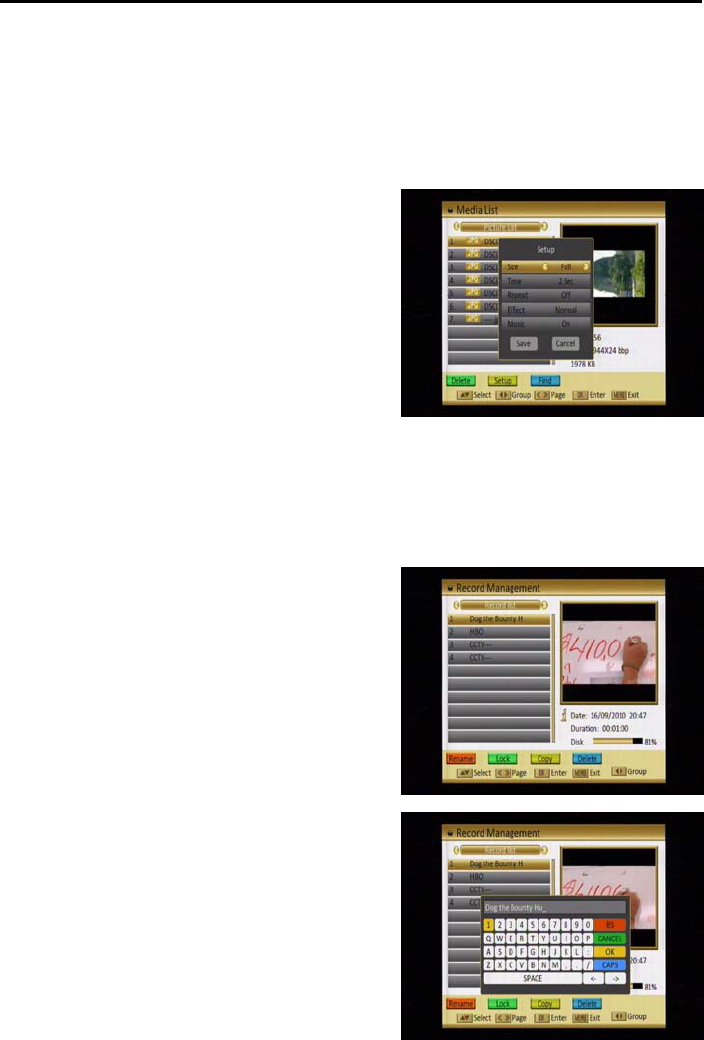
42
Menu Settings
7.1.6 Picture List
Basically the operation of “Picture List” is same as “Music List”, except that in
the Yellow (Setup) buttons offer further functions to manage.
Press [Yellow] button to open the “Setup” window.
Select the item you want to adjust with [CH▲/▼] and change the value with
[VOL◄/►]
Size: Full and Real.
Time: 0 Sec, 1 Sec, 2 Sec, 3 Sec, 4 Sec, 5
Sec, 6 Sec, 7 Sec, 8 Sec and 9 Sec.
Repeat: On and Off.
Effect: Normal, Shutters, Brush, Slide,
Random and Fade.
Mp3: On and Off.
7.1.7 Video list
Basically the operation of “Video List” is same as “Music List”.
7.1.8 Record list
If you enter the Record list menu a window
like the one below will open.
The color buttons offer further functions to
manage the channel list.
[Rename]
1. Press [Red] button to open the
“Rename” window like showed beside.
Press [CH▲/▼] / [Vol◄/►] to select
the leading character of the channel
name and press [OK] to confirm it.
2. After entering the character(s) highlight
“OK” in the window and press [OK] on
the RCU.
3. Press [Exit] button to close the find
window and brings you back to the
Record list.
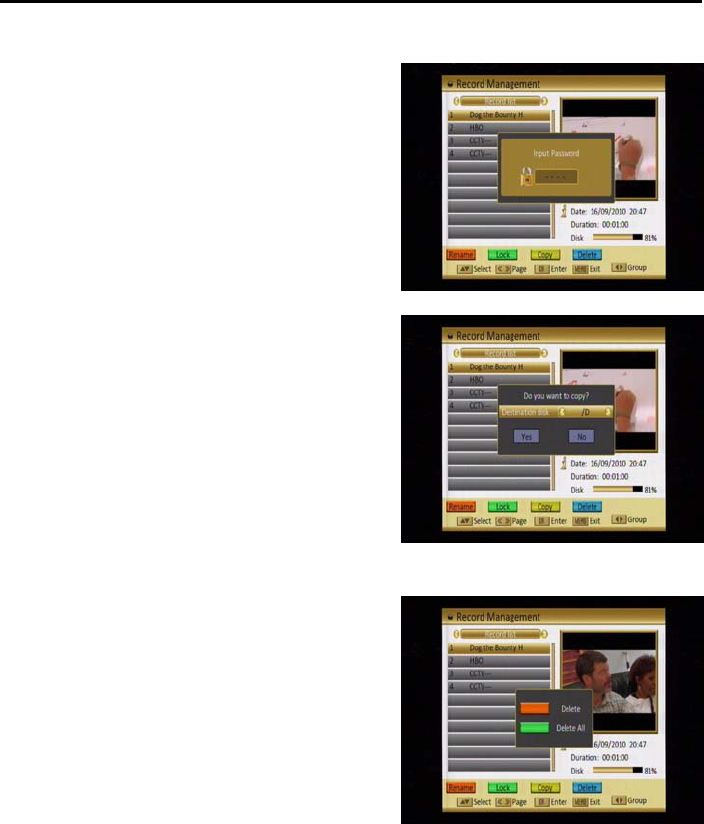
43
Menu Settings
[Lock]
In channel Record menu, press [Green]
button to place a lock icon behind the name
of the highlighted Record. Marked Records
will be locked and displayed only after
password has been entered if you confirm
to save the changes when you leave this
menu.
[Copy]
In channel Record menu, press [Yellow]
button copy the recorded programme to
another disk.
Press [Vol◄/►] to switch select copy path,
Select “OK” to add all image. Select
“Cancel” to cancel the operation.
[Delete]
In channel Record menu, press [Red]
button will open another window where you
can choose between add one image and
add all image.
Del One
Press [Red] button to mark a image
for add. Marked image will be add
after you confirm to save the changes
when you leave this menu.
Del All
c) Press [Green] button to show a add icon behind all image name.
d) Press [MENU] button you will be asked “Are you sure to save?”. Select
“OK” to add all image. Select “Cancel” to cancel the operation.
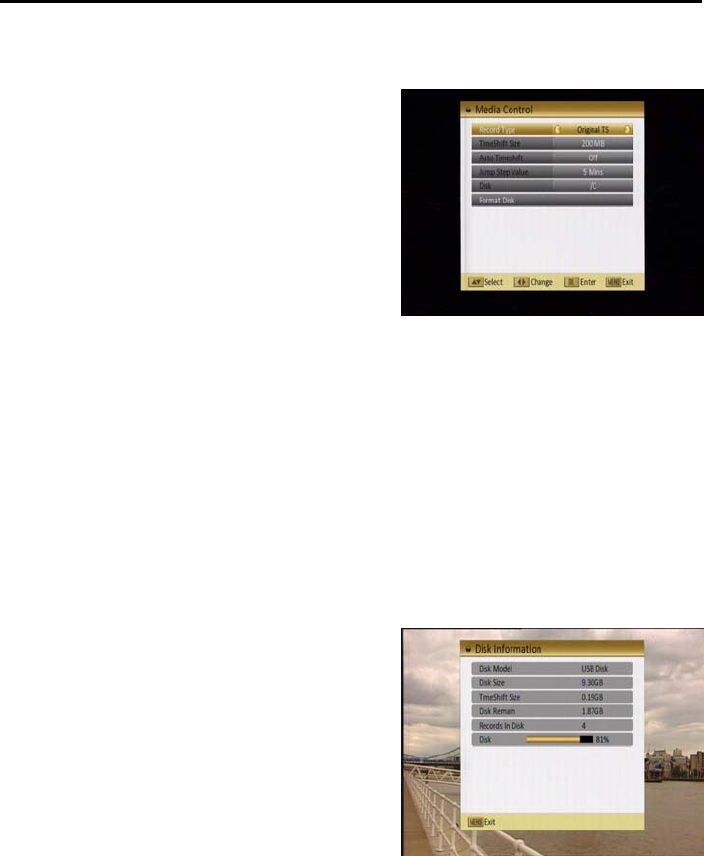
44
Menu Settings
7.2 Media Control
1. Reserved TMS Size: Press [Vol◄/►]
to switch between “0 MB / 200 MB and
500 MB”.
Select “MENU / EXIT”, press [MENU /
EXIT] to reset to make tms size valid
now. Select “Cancel” press [OK] to
cancel the operation.
2. Jump Step Value: Press [Vol◄/►] to
switch between “1 mins / 3 Mins / 5
Mins / 10 Mins / 15 Mins”.
The value control the step of I◄◄/►►I operation.
3. Record Type: Press [Vol◄/►] to switch between “TS and PS”.
4. Disk: Press [Vol◄/►] to switch between /C /D.....
5. Format Disk: If you want to delete the hard disk totally, you can do it with
the [OK] Button Format and the hard disk will be completely erased.
Caution: This process will delete also saves you have made with Backup
tools.
7.3 Disk Information
1. When you select the “Disk
Information” menu you will see a
screen like beside. The screen
displays data about the current HDD.
2. Press [Exit] button to leave the
information display.
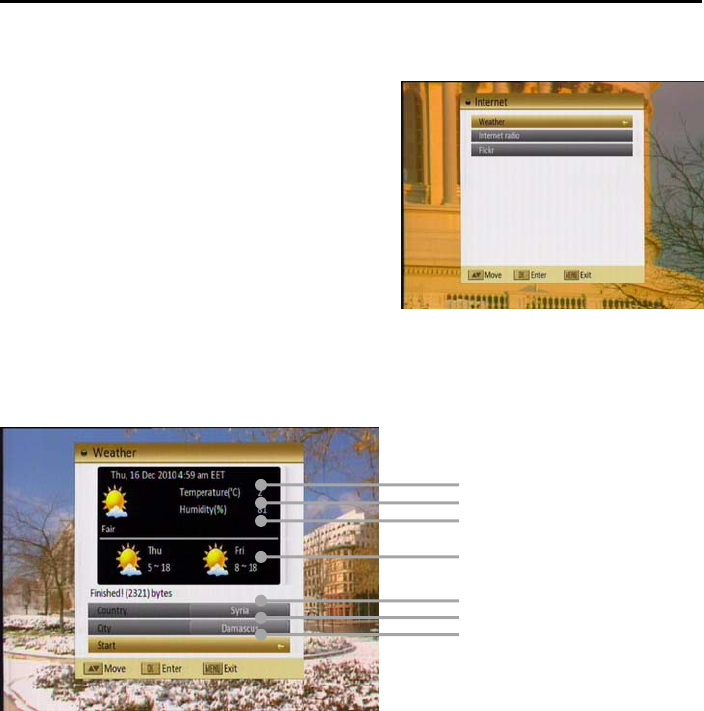
45
Menu Settings
8. Internet
When you enter to “Internet” menu, you will
see a screen like beside:
In “Media Management” menu:
1. Press [CH▲/▼] to select the Weather,
Internet radio and Flickr.
2. Press [OK] to enter the selected item.
8.1 Weather
The correct network configuration allows receiving actual Weather data.
1. Display of the current time and date.
2. Display of the current temperature.
3. Display of the humidity.
4. Display of the lowest and highest temperature of the day and next day’s
preview.
5. Selection of the country, to navigate with [Vol◄/►].
6. Selection of the City, to navigate with [Vol◄/►].
7. Actualization of the data with [start].
Note: According to network capacity the connection time may varies.
1
2
3
4
5
6
7
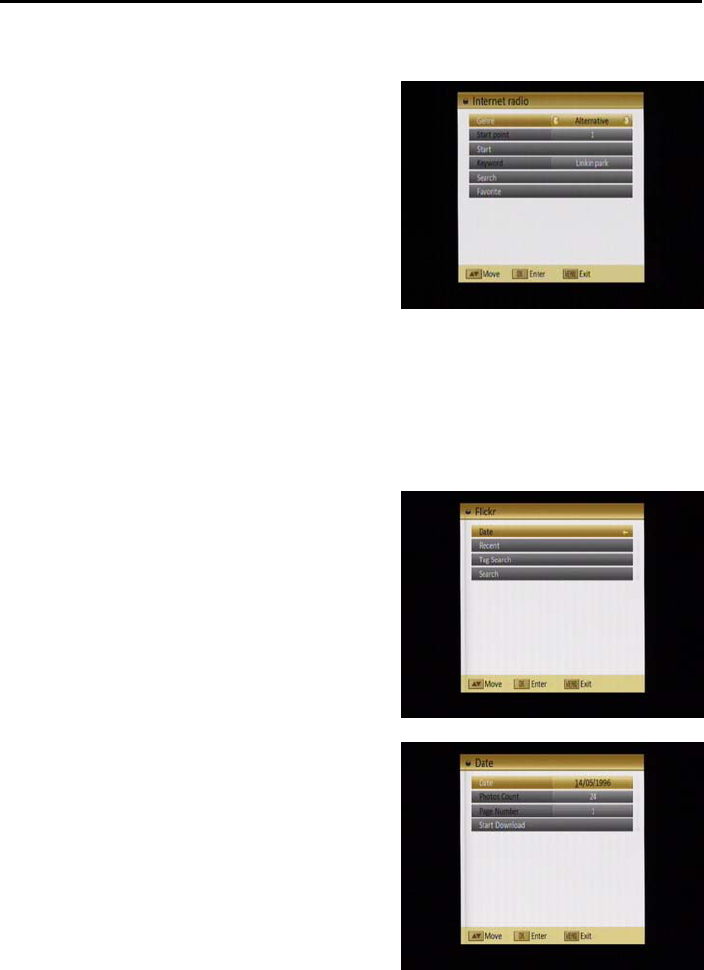
46
Menu Settings
8.2 Internet Radio
1. Please select “Genre” and set the
program type by using the [Vol◄/►] on
your remote control.
2. Please select” start point” and set the
routine by using the Number buttons on
your remote control.
After finish above two steps, then move
to “start” to confirm with [OK].
3. Please select” key word” and set the
singer name you preferred by using the Number buttons on your remote
control in case is not preconfigured.
After finish step 3, then move to “search” to confirm with [OK]
Note: According to network capacity the loading time may varies.
8.3 Flickr
The main menu contains 4 modules: Date,
Recent, Tag Search and Search
You can choose their way to share the
photos list, and you can choose a photo to
show the full screen by photo size (small,
middle, original)
8.3.1 Date
You can input Date, Photos count and Page
Number. Then start to download date
interesting photos.
Date—Default is 2009-01-01. Today and
yesterday’s photo sets maybe are null.
Photos count—Default is 24, max is 30.
Page Number—Default is 1, max is 80.
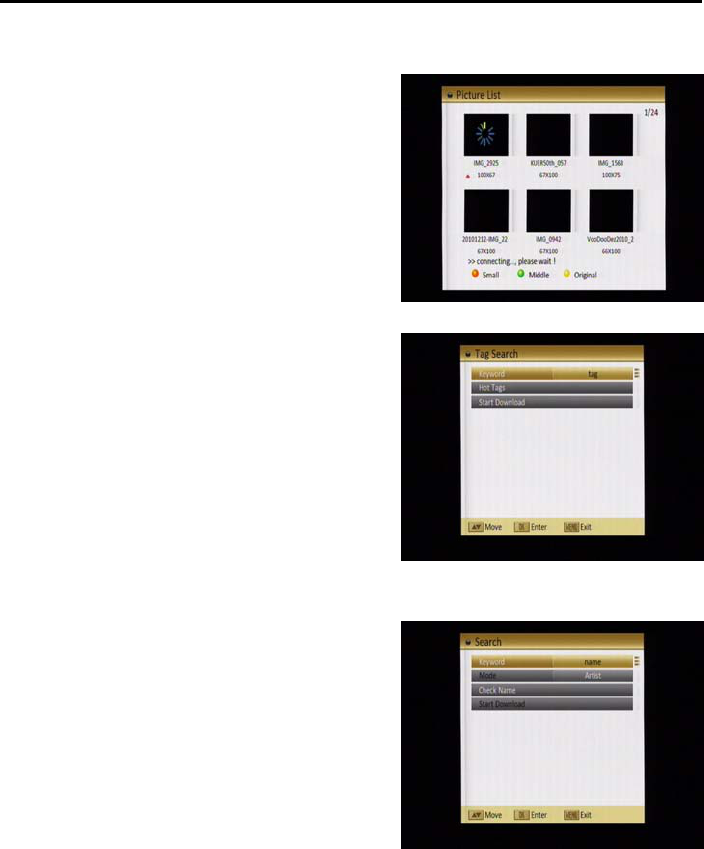
47
Menu Settings
8.3.2 Recent
The Recent is the newest upload photos.
It changes every time when you access,
because the site update it when some
people upload.
8.3.3 Tag Search
The Tag search contains input tag and Hot
tags search.
Input Tag—The users are able to input their
interesting tag, then start download photos
with the tag.
Hot Tags—If use the hot tags function, you
must first download hot tags and select one,
then download the photos with the hot tag.
8.3.4 Search
The search contains artist and group mode.
Artist Search---Users input the user name
(name signed in flickr), first check if it is
valid, then download the artist’s photos.
Group Search—Users input name of group,
first check sensitive groups and select one,
then download the group’s photos.

48
Technical Specification
9. Technical Specification
VIDEO
Decoding MPEG4 / H.264 and MPEG-2 compatible
Output NTSC/480P/720P/1080i
Aspect ratio 4:3PS, 4:3LB, 16:9, Auto
AUDIO
Decoding MPEG-2/MPEG-1 layer I & II, AAC, Dolby AC3
Sampling rate 32 / 44.1 / 48
DEMODULATOR
Demodulation 16~ 256 QAM, Annex B
INPUT SIGNAL
RF Input Type F; 75 Ohms
Frequency 54MHz ~ 864MHz
Input level -20dBmV -20dBmV
OUTPUT Connections
V/L/R Composite Video and analog L/R audio
YPbPr Component Video
HDMI Version 1.2, with HDCP v1.3c
MISCELLANEOUS
Supply voltage 120VAC 60Hz
Power consumption Max. 20 watts
Operation temperature +5° to +40°
Storage temperature -20° to +70°
Dimension (W * D * H) 310 * 260 * 60 mm
Weight 2.0 Kg

49
Contents
Contents
1. Settop Description & Remote Control .................................................................. 4
1.1 Settop Description ............................................................................................... 4
1.2 Front Panel Description ....................................................................................... 4
1.3 Rear Panel Description ....................................................................................... 6
1.4 Remote Control Description ................................................................................ 8
2. Basic Operation ...................................................................................................... 9
2.1 Switch ‘ON’ the Settop ........................................................................................ 9
2.2 Standby Mode ..................................................................................................... 9
2.3 MUTE ................................................................................................................ 10
2.4 AUDIO ............................................................................................................... 10
2.5 LAST ................................................................................................................. 10
2.6 Channel Numbers ............................................................................................. 10
2.7 PPV ................................................................................................................... 10
2.8 GUIDE ............................................................................................................... 10
2.9 CH ▲/▼ ........................................................................................................... 12
2.10 VOL ◄/► ........................................................................................................ 12
2.11 OK ................................................................................................................... 12
2.12 MENU ............................................................................................................. 12
2.13 EXIT ................................................................................................................ 12
2.14 PAUSE ............................................................................................................ 12
2.15 ZOOM ............................................................................................................. 13
2.16 INFO ............................................................................................................... 13
3. Channel .................................................................................................................. 14
3.1 TV Channel List ................................................................................................ 14
3.1.1 Favorite ...................................................................................................... 15
3.1.2 Move ........................................................................................................... 15
3.1.3 Sort ............................................................................................................. 16
3.1.4 Edit ............................................................................................................. 16
3.1.5 Find ............................................................................................................ 18
3.2 Radio Channel List ............................................................................................ 18
3.3 Channel Setup .................................................................................................. 19
3.4 Favorite group list name .................................................................................... 20
3.5 Delete All ........................................................................................................... 20
4. Cable Installation .................................................................................................. 21
4.1 Manual scan ...................................................................................................... 21
4.2 Auto Scan ......................................................................................................... 22
5. System Setup ........................................................................................................ 23
5.1 Language .......................................................................................................... 23
5.2 TV System ........................................................................................................ 24
5.3 Time & Timer Setting ........................................................................................ 25
5.4 OSD Setting ...................................................................................................... 28
5.5 Parental Lock .................................................................................................... 28
5.6 Power setting .................................................................................................... 29
5.7 TCP/IP Setting .................................................................................................. 30
5.8 MAC Setting ...................................................................................................... 31
6. Tools ....................................................................................................................... 32
6.1 Information ........................................................................................................ 32
6.2 Quick Setup ...................................................................................................... 32
6.3 Factory Default .................................................................................................. 33
6.4 Software Upgrade ............................................................................................. 33

50
Contents
6.4.1 USB-STB Upgrade ..................................................................................... 33
6.4.2 STB-STB Upgrade ...................................................................................... 34
6.4.3 Backup To USB .......................................................................................... 35
6.4.4 OTA Upgrade ............................................................................................. 35
6.4.5 Net Upgrade ............................................................................................... 35
6.5 SatcoDX Auto Programming ............................................................................. 36
6.6 CAS ................................................................................................................... 36
7. Media Management ............................................................................................... 37
7.1 Media List .......................................................................................................... 37
7.1.1 All ............................................................................................................... 38
7.1.2 Music .......................................................................................................... 41
7.1.3 Picture ........................................................................................................ 41
7.1.4 Video .......................................................................................................... 41
7.1.5 Music List ................................................................................................... 41
7.1.6 Picture List .................................................................................................. 42
7.1.7 Video list ..................................................................................................... 42
7.1.8 Record list .................................................................................................. 42
7.2 Media Control .................................................................................................... 44
7.3 Disk Information ................................................................................................ 44
8. Internet ................................................................................................................... 45
8.1 Weather ............................................................................................................ 45
8.2 Internet Radio ................................................................................................... 46
8.3 Flickr ................................................................................................................. 46
8.3.1 Date ............................................................................................................ 46
8.3.2 Recent ........................................................................................................ 47
8.3.3 Tag Search ................................................................................................. 47
8.3.4 Search ........................................................................................................ 47
9. Technical Specification ........................................................................................ 48